Cleveland
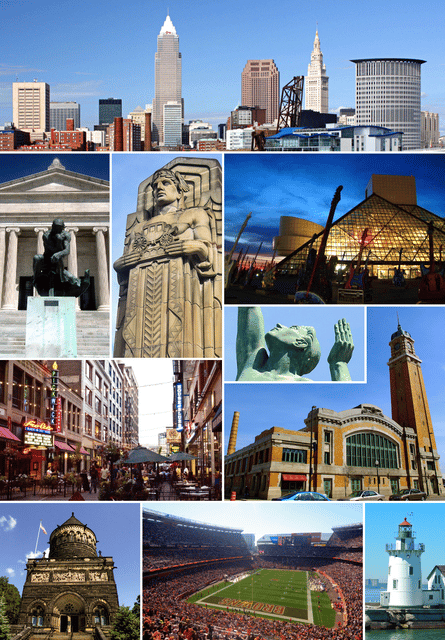
Cleveland

| City of Cleveland | |
| Nicknames: | |
| Motto(s): | |
| Coordinates: | |
| Country | United States |
|---|---|
| State | Ohio |
| County | Cuyahoga |
| Founded | July 22, 1796 |
| Incorporated | December 23, 1814 (village) |
| March 6, 1836 (city)[4] | |
| Named for | Moses Cleaveland |
| Government | |
| • Type | Mayor–council |
| • Body | Cleveland City Council |
| •Mayor | Frank G. Jackson(D) |
| Area | |
| •City | 82.47 sq mi (213.60 km) |
| • Land | 77.70 sq mi (201.24 km) |
| • Water | 4.77 sq mi (12.35 km) |
| • Urban | 772 sq mi (1,999.4 km) |
| • Metro | 3,979 sq mi (10,307 km) |
| •CSA | 11,624.49 sq mi (30,107.4 km) |
| Elevation | 653 ft (199 m) |
| Population | |
| •City | 396,698 |
| • Estimate | 383,793 |
| • Rank | US:52nd |
| • Density | 5,107.0/sq mi (1,971.8/km) |
| •Urban | 1,780,673 (US:25th) |
| •Metro | 2,057,009 (US:33rd) |
| •CSA | 3,599,264 (US:17th) |
| Demonym(s) | Clevelander |
| Time zone | UTC−5(EST) |
| UTC−4(EDT) | |
| ZIP Codes | |
| Area code | 216 |
| FIPS code | 39-16000 |
| GNISfeature ID | 1066654[6] |
| Primary Airport | Cleveland Hopkins International Airport |
| Interstates | |
| Rapid Transit | |
| Website | Cleveland-OH.gov[314] |
Cleveland (/ˈkliːvlənd/ KLEEV-lənd) is a city in the U.S. state of Ohio, and the county seat of Cuyahoga County.[10] The city proper has a population of 383,793, making it the 52nd-largest city in the United States and the second-largest city in Ohio.[8] Greater Cleveland is ranked as the 33rd-largest metropolitan area in the U.S., with 2,057,009 people in 2018.[11] A Gamma + city, Cleveland anchors the Cleveland–Akron–Canton Combined Statistical Area, which had a population of 3,515,646 in 2010 and is ranked 15th in the United States.
The city is located on the southern shore of Lake Erie, across the U.S. maritime border with Canada and approximately 60 miles (100 kilometers) west of the Ohio-Pennsylvania state border. It was founded in 1796 near the mouth of the Cuyahoga River by General Moses Cleaveland. It became a manufacturing center due to its location on both the river and the lake shore, as well as being connected to numerous canals and railroad lines. Cleveland's economy relies on diversified sectors such as manufacturing, financial services, healthcare, and biomedicals. Cleveland is also home to the Rock and Roll Hall of Fame.
Cleveland residents are called "Clevelanders". The city has many nicknames, the oldest of which in contemporary use being "The Forest City".[12]
| City of Cleveland | |
| Nicknames: | |
| Motto(s): | |
| Coordinates: | |
| Country | United States |
|---|---|
| State | Ohio |
| County | Cuyahoga |
| Founded | July 22, 1796 |
| Incorporated | December 23, 1814 (village) |
| March 6, 1836 (city)[4] | |
| Named for | Moses Cleaveland |
| Government | |
| • Type | Mayor–council |
| • Body | Cleveland City Council |
| •Mayor | Frank G. Jackson(D) |
| Area | |
| •City | 82.47 sq mi (213.60 km) |
| • Land | 77.70 sq mi (201.24 km) |
| • Water | 4.77 sq mi (12.35 km) |
| • Urban | 772 sq mi (1,999.4 km) |
| • Metro | 3,979 sq mi (10,307 km) |
| •CSA | 11,624.49 sq mi (30,107.4 km) |
| Elevation | 653 ft (199 m) |
| Population | |
| •City | 396,698 |
| • Estimate | 383,793 |
| • Rank | US:52nd |
| • Density | 5,107.0/sq mi (1,971.8/km) |
| •Urban | 1,780,673 (US:25th) |
| •Metro | 2,057,009 (US:33rd) |
| •CSA | 3,599,264 (US:17th) |
| Demonym(s) | Clevelander |
| Time zone | UTC−5(EST) |
| UTC−4(EDT) | |
| ZIP Codes | |
| Area code | 216 |
| FIPS code | 39-16000 |
| GNISfeature ID | 1066654[6] |
| Primary Airport | Cleveland Hopkins International Airport |
| Interstates | |
| Rapid Transit | |
| Website | Cleveland-OH.gov[314] |
History
Establishment
Cleveland was established on July 22, 1796 by surveyors of the Connecticut Land Company when they laid out Connecticut's Western Reserve into townships and a capital city. They named the new settlement "Cleaveland" after their leader, General Moses Cleaveland.[13] Cleaveland oversaw the New England-style design of the plan for what would become the modern downtown area, centered on Public Square, before returning home, never again to visit Ohio.[13] The first permanent settler in Cleaveland was Lorenzo Carter, who built a cabin on the banks of the Cuyahoga River.[14]
The Village of Cleaveland was incorporated on December 23, 1814.[15] In spite of the nearby swampy lowlands and harsh winters, the town's waterfront location proved to be an advantage, giving it access to Great Lakes trade.
It grew rapidly after the 1832 completion of the Ohio and Erie Canal. This key link between the Ohio River and the Great Lakes connected it to the Atlantic Ocean via the Erie Canal and Hudson River, and later via the St. Lawrence Seaway. Its products could reach markets on the Gulf of Mexico via the Mississippi River. The town's growth continued with added railroad links.[16]
In 1831, the spelling of the town's name was altered by The Cleveland Advertiser newspaper. In order to fit the name on the newspaper's masthead, the editors dropped the first "a", reducing the city's name to Cleveland, which eventually became the official spelling.[17] In 1836, Cleveland was officially incorporated as a city.[15] That same year, Cleveland, then only on the eastern banks of the Cuyahoga River, nearly erupted into open warfare with neighboring Ohio City over a bridge connecting the two communities.[18] Ohio City remained an independent municipality until its annexation by Cleveland in 1854.[15]
Growth and expansion
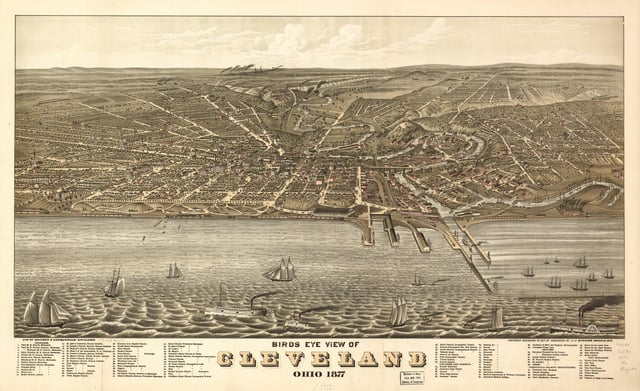
Bird's-eye view of Cleveland in 1877.
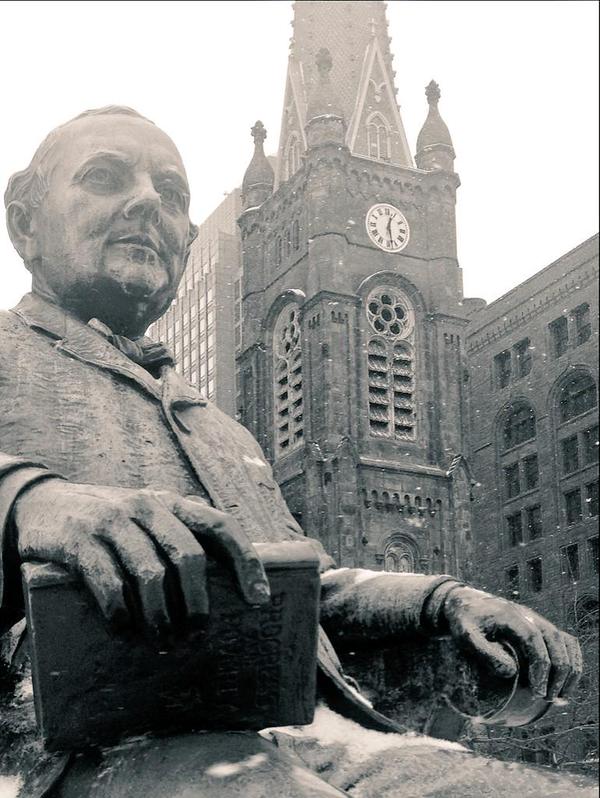
Herman Matzen's statue of Cleveland Mayor Tom L. Johnson.
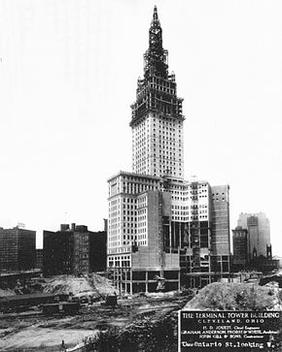
Cleveland's iconic Terminal Tower under construction in 1927.
Cleveland witnessed rapid growth after the American Civil War. The city's prime geographic location as a transportation hub between the East Coast and the Midwest played an important role in its development as a commercial center. Cleveland served as a destination for iron ore shipped from Minnesota, along with coal transported by rail. In 1870, John D. Rockefeller founded Standard Oil in Cleveland. In 1885, he moved its headquarters to New York City, which had become a center of finance and business.[19]
By the early 20th century, Cleveland had emerged as a major American manufacturing center.
Its businesses included automotive companies such as Peerless, People's, Jordan, Chandler, and Winton, maker of the first car driven across the U.S. Other manufacturers in Cleveland produced steam-powered cars, which included White and Gaeth, as well as the electric car company Baker.[20]
Known as the "Sixth City" due to its position as the sixth largest U.S. city at the time, Cleveland counted major Progressive Era politicians among its leaders, most prominently the populist Mayor Tom L. Johnson, who was responsible for the development of the Cleveland Mall Plan.[21][22][23] The era of the City Beautiful movement in Cleveland architecture, this period also saw wealthy patrons support the establishment of the city's major cultural institutions. The most prominent among them were the Cleveland Museum of Art, which opened in 1916, and the Cleveland Orchestra, established in 1918.[24][25]
Cleveland's economic growth and industrial jobs attracted large waves of immigrants from Southern and Eastern Europe as well as Ireland.[26] African American migrants from the rural South also arrived in Cleveland (among other Northeastern and Midwestern cities) as part of the Great Migration for jobs, constitutional rights, and relief from racial discrimination.[27] By 1920, the year in which the Cleveland Indians won their first World Series championship, Cleveland's population reached 796,841 with a foreign-born population of 30%, making it the fifth largest city in the nation.[28][29] At this time, Cleveland saw the rise of radical labor movements in response to the conditions of the largely immigrant and migrant workers. In 1919, the city attracted national attention amid the First Red Scare for the Cleveland May Day Riots, in which socialist demonstrators clashed with anti-socialists.[30][31]
Despite the immigration restrictions of 1921 and 1924, the city's population continued to grow throughout the 1920s. Prohibition first took effect in Ohio in May 1919 (although it was not well-enforced in Cleveland), became law with the Volstead Act in 1920, and was eventually repealed nationally by Congress in 1933.[32] The ban on alcohol led to the rise of speakeasies throughout the city and organized crime gangs, such as the Mayfield Road Mob, who smuggled bootleg liquor across Lake Erie from Canada into Cleveland.[32][33] The Roaring Twenties also saw the establishment of Cleveland's Playhouse Square and the rise of the risqué Short Vincent entertainment district.[34][35][36] The Bal-Masque balls of the avant-garde Kokoon Arts Club scandalized the city.[37][38] Jazz came to prominence in Cleveland during this period.[39][40][41]
In 1929, the city hosted the first of many National Air Races.[42] Construction of the Terminal Tower skyscraper commenced in 1926 and, by the time it was dedicated in 1930, Cleveland had a population of over 900,000.[43][28] The era of the flapper also marked the beginning of the golden age in Downtown Cleveland retail, centered on major department stores Higbee's, Bailey's, the May Company, Taylor's, Halle's, and Sterling Lindner Davis, which collectively represented one of the largest and most fashionable shopping districts in the country, often compared to New York's Fifth Avenue.[44]
Cleveland was hit hard by the Wall Street Crash of 1929 and the subsequent Great Depression. A center of union activity, the city was aided by major federal works projects sponsored by President Franklin D. Roosevelt's New Deal.[45] In commemoration of the centennial of Cleveland's incorporation as a city, the Great Lakes Exposition debuted in June 1936 at the city's North Coast Harbor, along the Lake Erie shore north of downtown.[46] Conceived by Cleveland's business leaders as a way to revitalize the city during the Depression, it drew four million visitors in its first season, and seven million by the end of its second and final season in September 1937.[47]
On December 7, 1941, Imperial Japan attacked Pearl Harbor and declared war on the United States. One of the victims of the attack was a Cleveland native, Rear Admiral Isaac C. Kidd.[48] The attack signaled America's entry into World War II. A major hub of the "Arsenal of Democracy", Cleveland under Mayor Frank Lausche contributed massively to the U.S. war effort as the fifth largest manufacturing center in the nation.[48] During his tenure, Lausche also oversaw the establishment of the Cleveland Transit System, the predecessor to the Greater Cleveland Regional Transit Authority.[49]
Late 20th and early 21st centuries
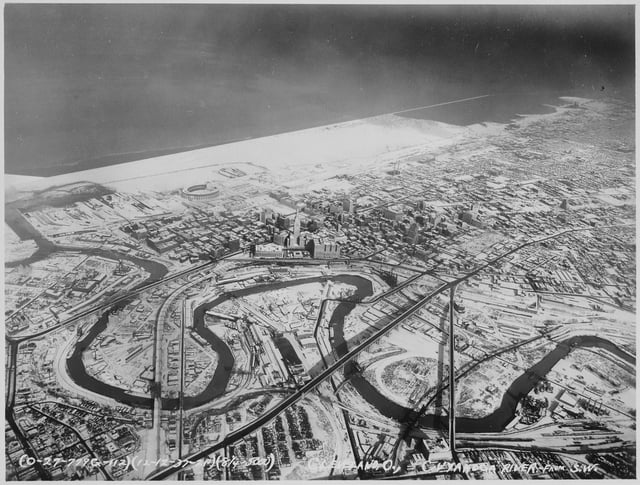
The Cuyahoga River winds through the Flats in a December 1937 aerial view of Downtown Cleveland.
After the war, Cleveland initially experienced an economic boom, and businesses declared the city to be the "best location in the nation."[50][51] In 1949, the city was named an All-America City for the first time and, in 1950, its population reached 914,808.[52][28] In sports, the Indians won the 1948 World Series, the hockey team, the Barons, became champions of the American Hockey League, and the Browns dominated professional football in the 1950s. As a result, along with track and boxing champions produced, Cleveland was declared the "City of Champions" in sports at this time. The 1950s also saw the rising popularity of a new music genre that local WJW (AM) disc jockey Alan Freed dubbed "rock and roll."[53]
However, by the 1960s, Cleveland's economy began to slow down, and residents increasingly sought new housing in the suburbs, reflecting the national trends of suburban growth following federally subsidized highways.[54] Industrial restructuring, particularly in the railroad and steel industries, resulted in the loss of numerous jobs in Cleveland and the region, and the city suffered economically.
The burning of the Cuyahoga River in June 1969 brought national attention to the issue of industrial pollution in Cleveland and served as a catalyst for the American environmental movement.[55]
Housing discrimination and redlining against African Americans led to racial unrest in Cleveland and numerous other Northern U.S. cities.[56][57] In Cleveland, the Hough riots erupted from July 18 to 23, 1966 and the Glenville Shootout took place from July 23 to 25, 1968.[27] In November 1967, Cleveland became the first major American city to elect an African American mayor, Carl B. Stokes, who served from 1968 to 1971.[58]
In December 1978, during the turbulent tenure of Dennis Kucinich as mayor, Cleveland became the first major American city since the Great Depression to enter into a financial default on federal loans.[59] By the beginning of the 1980s, several factors, including changes in international free trade policies, inflation, and the Savings and Loans Crisis, contributed to the recession that severely affected cities like Cleveland.[60] While unemployment during the period peaked in 1983, Cleveland's rate of 13.8% was higher than the national average due to the closure of several steel production centers.[61][62][63]
The city began a gradual economic recovery under mayor George V. Voinovich in the 1980s. The downtown area saw the construction of the Key Tower and 200 Public Square skyscrapers, as well as the development of the Gateway Sports and Entertainment Complex—consisting of Progressive Field and Rocket Mortgage FieldHouse—and the North Coast Harbor, including the Rock and Roll Hall of Fame, FirstEnergy Stadium, and the Great Lakes Science Center.[64] The city emerged from default in 1987.[15]
By the turn of the 21st century, Cleveland succeeded in developing a more diversified economy and gained a national reputation as a center for healthcare and the arts.
Additionally, it has become a national leader in environmental protection, with its successful cleanup of the Cuyahoga River.[65] The city's downtown has experienced dramatic economic and population growth since 2010.[66] In 2018, the population of Cleveland began to flatten after decades of decline.[67] However, challenges still remain for the city, with economic development of neighborhoods, improvement of city schools, and continued encouragement of new immigration to Cleveland being top municipal priorities.[68][69] Despite such challenges, Cleveland has become increasingly recognized by national media as a city on the upswing.[70] This trend has been accompanied by major victories in sports, most prominently the victory of the Cleveland Cavaliers in the 2016 NBA Finals, the first major professional sports championship won by a Cleveland team since 1964.[71]
Geography
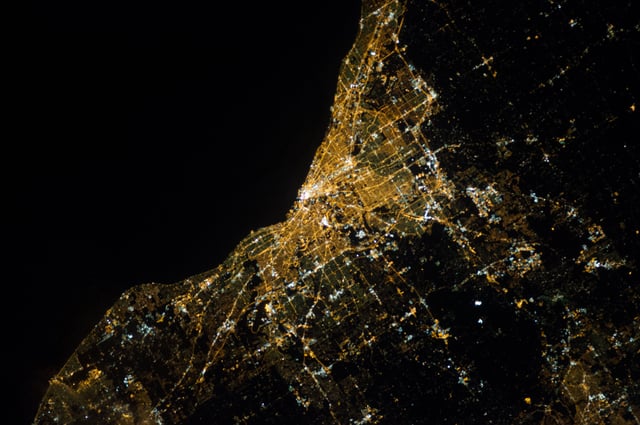
NASA satellite photograph of Cleveland at night.
According to the United States Census Bureau, the city has a total area of 82.47 square miles (213.60 km2), of which 77.70 square miles (201.24 km2) is land and 4.77 square miles (12.35 km2) is water.[5] The shore of Lake Erie is 569 feet (173 m) above sea level; however, the city lies on a series of irregular bluffs lying roughly parallel to the lake. In Cleveland these bluffs are cut principally by the Cuyahoga River, Big Creek, and Euclid Creek.
The land rises quickly from the lake shores elevation of 569 feet.
Public Square, less than one mile (1.6 km) inland, sits at an elevation of 650 feet (198 m), and Hopkins Airport, 5 miles (8 km) inland from the lake, is at an elevation of 791 feet (241 m).[72]
Cleveland borders several inner-ring and streetcar suburbs. To the west, it borders Lakewood, Rocky River, and Fairview Park, and to the east, it borders Shaker Heights, Cleveland Heights, and East Cleveland. To the southwest, it borders Linndale, Brooklyn, Parma, and Brook Park. The city also borders Newburgh Heights, Cuyahoga Heights, and Brooklyn Heights to the south, and Warrensville Heights, Maple Heights, and Garfield Heights to the southeast. To the northeast, along the shore of Lake Erie, Cleveland borders Bratenahl and Euclid.
Cityscapes
Architecture
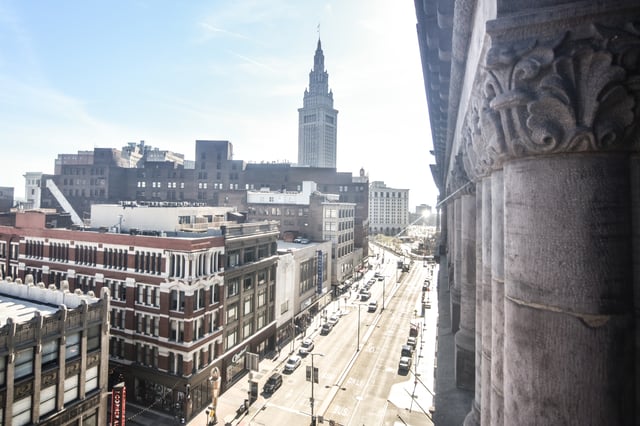
Terminal Tower and Euclid Avenue.
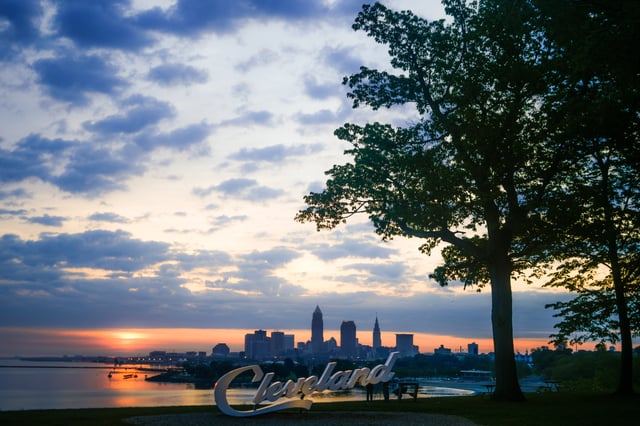
Downtown Cleveland from Edgewater Park.
Cleveland's downtown architecture is diverse.
Many of the city's government and civic buildings, including City Hall, the Cuyahoga County Courthouse, the Cleveland Public Library, and Public Auditorium, are clustered around the open Cleveland Mall and share a common neoclassical architecture. Built in the early 20th century, they are the result of the 1903 Group Plan. They constitute one of the most complete examples of City Beautiful design in the United States.[73][74]
The Terminal Tower, dedicated in 1930, was the tallest building in North America outside New York City until 1964 and the tallest in the city until 1991.[43] It is a prototypical Beaux-Arts skyscraper. The two newer skyscrapers on Public Square, Key Tower (currently the tallest building in Ohio) and the 200 Public Square, combine elements of Art Deco architecture with postmodern designs. Cleveland's architectural treasures also include the Cleveland Trust Company Building, completed in 1907 and renovated in 2015 as a downtown Heinen's supermarket, and the Cleveland Arcade (sometimes called the Old Arcade), a five-story arcade built in 1890 and renovated in 2001 as a Hyatt Regency Hotel.[75][76][77]
Running east from Public Square through University Circle is Euclid Avenue, which was known for its prestige and elegance as a residential street. In the late 1880s, writer Bayard Taylor described it as "the most beautiful street in the world".[78] Known as "Millionaire's Row", Euclid Avenue was world-renowned as the home of such major figures as John D. Rockefeller, Mark Hanna, and John Hay.[79][80][81]
Parks and nature
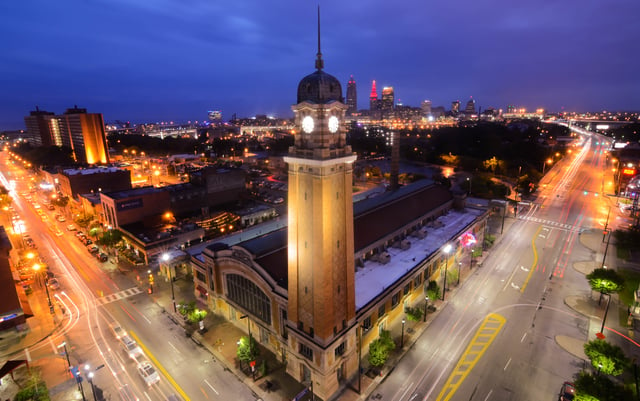
The historic Ohio City neighborhood at night.
Known locally as the "Emerald Necklace", the Olmsted-inspired Cleveland Metroparks encircle Cleveland and Cuyahoga County. The city proper is home to the Metroparks' Brookside and Lakefront Reservations, as well as significant parts of the Rocky River, Washington, and Euclid Creek Reservations. The Lakefront Reservation, which provides public access to Lake Erie, consists of four parks: Edgewater Park, Whiskey Island–Wendy Park, East 55th Street Marina, and Gordon Park.[86] Three more parks fall under the jurisdiction of the Euclid Creek Reservation: Euclid Beach, Villa Angela, and Wildwood Marina.[87] Also included in the system is the renowned Cleveland Metroparks Zoo, established in 1882. Located in Big Creek valley, the zoo has one of the largest collection of primates in North America.[88]
In addition to the Metroparks, Cleveland Public Parks District oversees the city's neighborhood parks, the largest of which is the historic Rockefeller Park, notable for its late 19th century landmark bridges, Rockefeller Park Greenhouse, and Cleveland Cultural Gardens, which celebrate the city's ethnic diversity.[89][90] Just outside of Rockefeller Park, the Cleveland Botanical Garden in University Circle, established in 1930, is the oldest civic garden center in the nation.[91] Located in the historic FirstEnergy Powerhouse in the Flats, the Greater Cleveland Aquarium is the only independent, free-standing aquarium in the state of Ohio.[92]
Neighborhoods
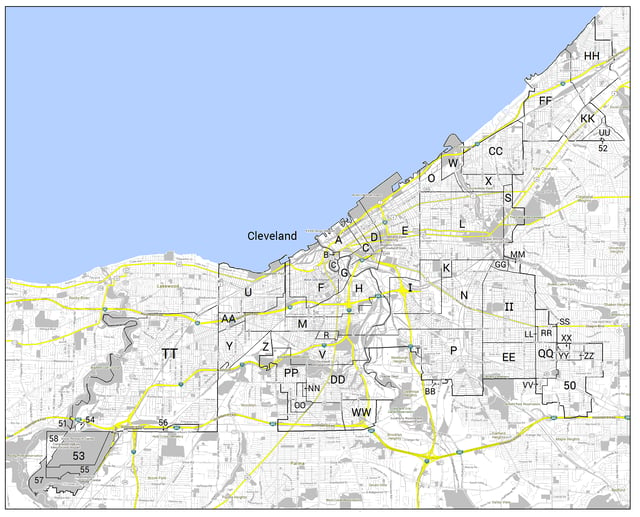
Map of the territorial evolution of Cleveland.
Downtown Cleveland is centered on Public Square and includes a wide range of districts. It contains the traditional Financial District and Civic Center, as well as the Cleveland Theater District, which is home to Playhouse Square Center. Downtown also historically included the lively Short Vincent entertainment district, which emerged in the 1920s and reached its height in the 1940s and 1950s.[35] Today the former Short Vincent forms part of the Financial District.[36] Mixed-use neighborhoods, such as the Flats and the Warehouse District, are occupied by industrial and office buildings as well as restaurants and bars. The number of downtown housing units, in the form of condominiums, lofts, and apartments, has been on the increase since 2000 and especially 2010. Recent developments include the revival of the Flats, the Euclid Corridor Project, and the developments along East 4th Street.[93][94]
Clevelanders geographically define themselves in terms of whether they live on the east or west side of the Cuyahoga River. The East Side includes the neighborhoods of Buckeye–Shaker, Central, Collinwood, Corlett, Euclid–Green, Fairfax, Forest Hills, Glenville, Goodrich–Kirtland Park (with Asiatown), Hough, Kinsman, Lee–Miles, Mount Pleasant, Nottingham, St. Clair-Superior, Union–Miles Park, University Circle (with Little Italy), and Woodland Hills. The West Side includes the neighborhoods of Brooklyn Centre, Clark–Fulton, Detroit–Shoreway, Cudell, Edgewater, Ohio City, Tremont, Old Brooklyn, Stockyards, West Boulevard, and the four neighborhoods colloquially known as West Park: Kamm's Corners, Jefferson, Puritas–Longmead, and Riverside. Three neighborhoods in the Cuyahoga Valley are sometimes referred to as the South Side: Industrial Valley, Broadway–Slavic Village, and Tremont.
Several neighborhoods have begun to attract the return of the middle class that left the city for the suburbs in the 1960s and 1970s.
These neighborhoods are on both the West Side (Ohio City, Tremont, Detroit-Shoreway, and Edgewater) and the East Side (Collinwood, Hough, Fairfax, and Little Italy).
Much of the growth has been spurred on by attracting creative class members, which in turn is spurring new residential development.[95] A live-work zoning overlay for the city's near East Side has facilitated the transformation of old industrial buildings into loft spaces for artists.[96]
Climate
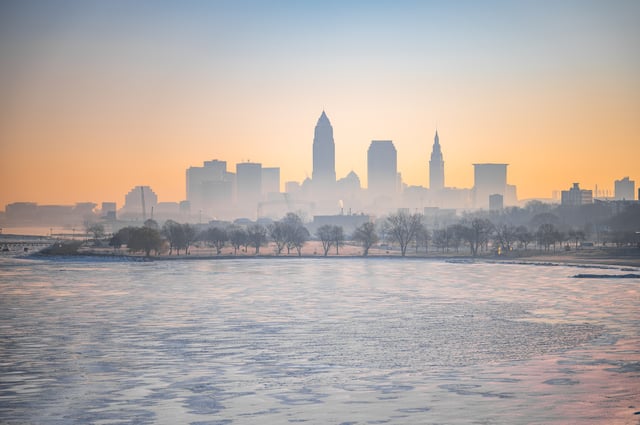
Cleveland and Lake Erie in winter.
Typical of the Great Lakes region, Cleveland exhibits a continental climate with four distinct seasons, which lies in the humid continental (Köppen Dfa)[97] zone. Summers are warm and humid while winters are cold and snowy. The Lake Erie shoreline is very close to due east–west from the mouth of the Cuyahoga west to Sandusky, but at the mouth of the Cuyahoga it turns sharply northeast. This feature is the principal contributor to the lake effect snow that is typical in Cleveland (especially on the city's East Side) from mid-November until the surface of Lake Erie freezes, usually in late January or early February. The lake effect also causes a relative differential in geographical snowfall totals across the city: while Hopkins Airport, on the city's far West Side, has only reached 100 inches (254 cm) of snowfall in a season three times since record-keeping for snow began in 1893,[98] seasonal totals approaching or exceeding 100 inches (254 cm) are not uncommon as the city ascends into the Heights on the east, where the region known as the 'Snow Belt' begins. Extending from the city's East Side and its suburbs, the Snow Belt reaches up the Lake Erie shore as far as Buffalo.[99]
The all-time record high in Cleveland of 104 °F (40 °C) was established on June 25, 1988,[100] and the all-time record low of −20 °F (−29 °C) was set on January 19, 1994.[101] On average, July is the warmest month with a mean temperature of 73.5 °F (23.1 °C), and January, with a mean temperature of 28.1 °F (−2.2 °C), is the coldest. Normal yearly precipitation based on the 30-year average from 1981 to 2010 is 39.1 inches (990 mm).[102] The least precipitation occurs on the western side and directly along the lake, and the most occurs in the eastern suburbs. Parts of Geauga County to the east receive over 44 inches (1,100 mm) of liquid precipitation annually.[103]
| Climate data for Cleveland (Cleveland Airport), 1981–2010 normals, extremes 1871–present[1] | |||||||||||||
|---|---|---|---|---|---|---|---|---|---|---|---|---|---|
| Month | Jan | Feb | Mar | Apr | May | Jun | Jul | Aug | Sep | Oct | Nov | Dec | Year |
| Record high °F (°C) | 73(23) | 77(25) | 83(28) | 88(31) | 93(34) | 104(40) | 103(39) | 102(39) | 101(38) | 90(32) | 82(28) | 77(25) | 104(40) |
| Mean maximum °F (°C) | 56.9(13.8) | 59.8(15.4) | 73.2(22.9) | 80.7(27.1) | 85.0(29.4) | 91.6(33.1) | 92.7(33.7) | 91.0(32.8) | 87.3(30.7) | 79.4(26.3) | 69.8(21.0) | 58.5(14.7) | 93.9(34.4) |
| Average high °F (°C) | 34.4(1.3) | 37.5(3.1) | 46.6(8.1) | 59.1(15.1) | 69.5(20.8) | 78.6(25.9) | 82.6(28.1) | 80.8(27.1) | 73.9(23.3) | 62.3(16.8) | 50.8(10.4) | 38.3(3.5) | 59.6(15.3) |
| Average low °F (°C) | 21.7(−5.7) | 23.6(−4.7) | 30.2(−1.0) | 40.4(4.7) | 50.1(10.1) | 59.8(15.4) | 64.3(17.9) | 63.1(17.3) | 56.0(13.3) | 45.4(7.4) | 36.9(2.7) | 26.4(−3.1) | 43.3(6.3) |
| Mean minimum °F (°C) | 0.0(−17.8) | 3.2(−16.0) | 11.3(−11.5) | 24.7(−4.1) | 35.0(1.7) | 44.4(6.9) | 50.9(10.5) | 50.0(10.0) | 40.7(4.8) | 30.9(−0.6) | 21.2(−6.0) | 6.4(−14.2) | −4.6(−20.3) |
| Record low °F (°C) | −20(−29) | −17(−27) | −5(−21) | 10(−12) | 25(−4) | 31(−1) | 41(5) | 38(3) | 32(0) | 19(−7) | 0(−18) | −15(−26) | −20(−29) |
| Averageprecipitationinches (mm) | 2.72(69) | 2.34(59) | 2.93(74) | 3.49(89) | 3.66(93) | 3.43(87) | 3.46(88) | 3.51(89) | 3.81(97) | 3.07(78) | 3.62(92) | 3.10(79) | 39.14(994) |
| Average snowfall inches (cm) | 18.7(47) | 14.9(38) | 12.6(32) | 3.3(8.4) | 0(0) | 0(0) | 0(0) | 0(0) | 0(0) | 0.2(0.51) | 4.3(11) | 14.1(36) | 68.1(173) |
| Average precipitation days(≥ 0.01 in) | 17.1 | 13.9 | 14.2 | 14.4 | 13.2 | 11.1 | 10.3 | 9.8 | 10.0 | 11.4 | 13.5 | 16.0 | 154.9 |
| Average snowy days(≥ 0.1 in) | 13.5 | 10.1 | 7.5 | 2.3 | 0 | 0 | 0 | 0 | 0 | 0.2 | 3.3 | 10.0 | 46.9 |
| Averagerelative humidity(%) | 73.3 | 73.0 | 70.4 | 66.1 | 67.3 | 69.0 | 69.8 | 73.1 | 73.7 | 70.8 | 71.9 | 74.1 | 71.0 |
| Mean monthlysunshine hours | 101.0 | 122.3 | 167.0 | 216.0 | 263.6 | 294.6 | 307.2 | 262.2 | 219.0 | 169.5 | 89.8 | 67.8 | 2,280 |
| Percentpossible sunshine | 34 | 41 | 45 | 54 | 59 | 65 | 67 | 61 | 59 | 49 | 30 | 24 | 51 |
| Averageultraviolet index | 2 | 2 | 4 | 6 | 7 | 9 | 9 | 8 | 6 | 4 | 2 | 1 | 5 |
| Source #1: NOAA (relative humidity and sun 1961–1990)[104][undefined][106][undefined] | |||||||||||||
| Source #2: Weather Atlas[108](sunshine data) | |||||||||||||
Demographics
| Historical population | |||
|---|---|---|---|
| Census | Pop. | %± | |
| 1820 | 606 | — | |
| 1,075 | 77.4% | ||
| 1840 | 6,071 | 464.7% | |
| 17,034 | 180.6% | ||
| 1860 | 43,417 | 154.9% | |
| 92,829 | 113.8% | ||
| 1880 | 160,146 | 72.5% | |
| 261,353 | 63.2% | ||
| 1900 | 381,768 | 46.1% | |
| 560,663 | 46.9% | ||
| 1920 | 796,841 | 42.1% | |
| 900,429 | 13.0% | ||
| 1940 | 878,336 | −2.5% | |
| 914,808 | 4.2% | ||
| 1960 | 876,050 | −4.2% | |
| 750,903 | −14.3% | ||
| 1980 | 573,822 | −23.6% | |
| 505,616 | −11.9% | ||
| 2000 | 478,403 | −5.4% | |
| 396,815 | −17.1% | ||
| Est. 2018 | 383,793 | [109] | −3.3% |
| [28][110] | |||
2010 census
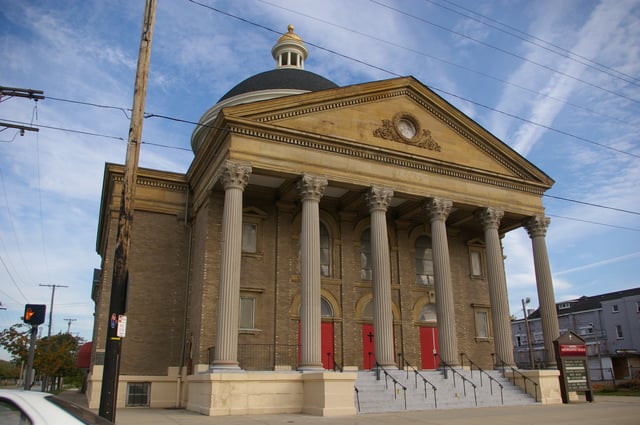
Originally built in 1905 as the Jewish Temple B'nai Jeshurun, this building on Cleveland's East Side, today known as the Shiloh Baptist Church, now serves the African American community.
As of the census[7] of 2010, there were 396,698 people, 167,490 households, and 89,821 families residing in the city. The population density was 5,107.0 inhabitants per square mile (1,971.8/km2). There were 207,536 housing units at an average density of 2,671.0 per square mile (1,031.3/km2). The racial makeup of the city was 53.3% African American, 37.3% White, 0.3% Native American, 1.8% Asian, 4.4% from other races, and 2.8% from two or more races. Hispanic or Latino of any race were 10.0% of the population.[111]
There were 167,490 households of which 29.7% had children under the age of 18 living with them, 22.4% were married couples living together, 25.3% had a female householder with no husband present, 6.0% had a male householder with no wife present, and 46.4% were non-families.
39.5% of all households were made up of individuals and 10.7% had someone living alone who was 65 years of age or older.
The average household size was 2.29 and the average family size was 3.11.
The median age in the city was 35.7 years.
24.6% of residents were under the age of 18; 11% were between the ages of 18 and 24; 26.1% were from 25 to 44; 26.3% were from 45 to 64; and 12% were 65 years of age or older.
The gender makeup of the city was 48.0% male and 52.0% female.
2000 census
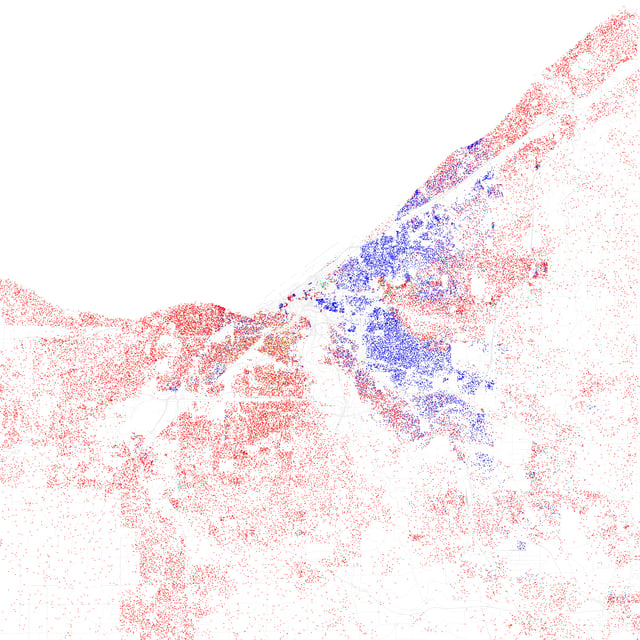
Map of racial distribution in Greater Cleveland, 2010 U.S.
As of the census of 2000, there were 478,403 people, 190,638 households, and 111,904 families residing in the city.
The population density was 6,166.5 inhabitants per square mile (2,380.9/km2).
There were 215,856 housing units at an average density of 2,782.4 per square mile (1,074.3/km2).
The racial makeup of the city was 51.0% African American, 41.5% White, 0.3% Native American, 1.3% Asian, 0.0% Pacific Islander, 3.6% from other races, and 2.2% from two or more races. Hispanic or Latinos of any race were 7.3% of the population.[113] Ethnic groups include Germans (15.2%), Irish (10.9%), English (8.7%), Italian (5.6%), Poles (3.2%), and French (3.0%). Out of the total population, 4.5% were foreign born; of which 41.2% were born in Europe, 29.1% Asia, 22.4% Latin American, 5.0% Africa, and 1.9% Northern America.[114]
Out of 190,638 households, 29.9% have children under the age of 18 living with them, 28.5% were married couples living together, 24.8% had a female householder with no husband present, and 41.3% were nonfamilies.
35.2% of all households were made up of individuals and 11.1% had someone living alone who is 65 years of age or older.
The average household size was 2.44 and the average family size was 3.19.
The age distribution of the population shows 28.5% under the age of 18, 9.5% from 18 to 24, 30.4% from 25 to 44, 19.0% from 45 to 64, and 12.5% who are 65 years of age or older.
The median age was 33 years.
For every 100 females, there were 90.0 males.
For every 100 females age 18 and over, there were 85.2 males.
The median income for a household in the city was US$25,928, and the median income for a family was $30,286. Males had a median income of $30,610 versus $24,214 for females. The per capita income for the city was $14,291. 26.3% of the population and 22.9% of families were below the poverty line. Out of the total population, 37.6% of those under the age of 18 and 16.8% of those 65 and older were living below the poverty line.[115]
Ethnicity
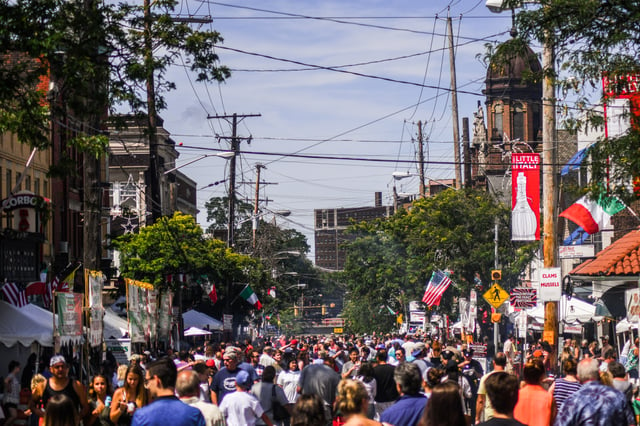
Feast of the Assumption in Little Italy.
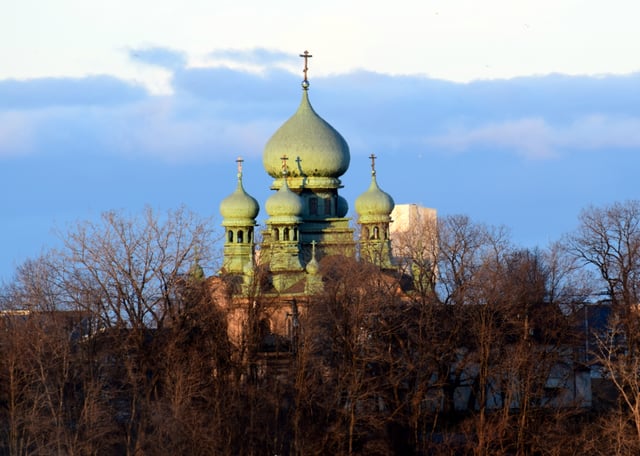
St. Theodosius Russian Orthodox Cathedral in Tremont.
In the 19th and early 20th centuries, Cleveland saw a massive influx of immigrants from Ireland, Italy, and the Austro-Hungarian, German, Russian, and Ottoman Empires, most of whom were attracted by manufacturing jobs.[26] As a result, Cleveland and Cuyahoga County today have substantial communities of Irish (especially in West Park), Italians (especially in Little Italy and around Mayfield Road), Germans, and several Central-Eastern European ethnicities, including Czechs, Hungarians, Lithuanians, Poles, Romanians, Russians, Rusyns, Slovaks, Ukrainians, and ex-Yugoslav groups, such as Slovenes, Croats, and Serbs.[26] The presence of Hungarians within Cleveland proper was, at one time, so great that the city boasted the highest concentration of Hungarians in the world outside of Budapest.[116] Cleveland has a long-established Jewish community, historically centered on the East Side neighborhoods of Glenville and Kinsman, but now mostly concentrated in East Side suburbs such as Beachwood, home to the Maltz Museum of Jewish Heritage.[117]
The availability of jobs also attracted African Americans from the South.
Between 1920 and 1970, the black population of Cleveland, largely concentrated on the city's East Side, increased significantly as a result of the First and Second Great Migrations.[27] Cleveland's Latino community consists primarily of Puerto Ricans, while the city's Asian community, centered on historical Asiatown, consists of Chinese, Koreans, Vietnamese, and other groups.[118][119] Additionally, the city and the county have significant communities of Arabs, Armenians, French, Greeks, Scots, Turks, and West Indians.[120][121][122][123][124][26]
There are many ethnic festivals held in Cleveland throughout the year, such as the annual Feast of the Assumption in Little Italy, the Harvest Festival in Slavic Village, Russian Maslenitsa in Rockefeller Park, the Cleveland Puerto Rican Parade and Festival in Clark–Fulton, and the Cleveland Asian Festival in Asiatown. Vendors at the West Side Market in Ohio City offer many ethnic foods for sale. Cleveland hosts an annual parade on Saint Patrick's Day that brings hundreds of thousands to the streets of downtown.[125] The Cleveland Thyagaraja Festival held annually each spring at Cleveland State University is the largest Indian classical music and dance festival in the world outside of India.[126] Since 1946, the city has annually marked One World Day in the Cleveland Cultural Gardens in Rockefeller Park, celebrating all of its ethnic communities.[90]
Religion
The influx of immigrants in the 19th and early 20th centuries drastically transformed Cleveland's religious landscape.
From a homogeneous settlement of New England Protestants, it evolved into a city with a diverse religious composition. The predominant faith among Clevelanders today is Christianity (Catholic, Protestant, and Orthodox), with Jewish, Muslim, Hindu, and Buddhist minorities.[127]
Language
As of 2010, 88.4% (337,658) of Cleveland residents age 5 and older spoke English at home as a primary language, while 7.1% (27,262) spoke Spanish, 0.6% (2,200) Arabic, and 0.5% (1,960) Chinese. In addition 0.9% (3,364) spoke a Slavic language (1,279 – Polish, 679 Serbo-Croatian, and 485 Russian). In total, 11.6% (44,148) of Cleveland's population age 5 and older spoke a language other than English.[128]
Immigration
In 1920, Cleveland proper boasted a foreign-born population of 30% and, in 1870, that percentage was 42%.[29] Although the foreign-born population of Cleveland today is not as big as it once was, the sense of identity remains strong among the city's various ethnic communities, as reflected in the Cleveland Cultural Gardens.
Recent waves of immigration to Cleveland have brought new groups to the city, including additional numbers of Russians and other nationalities from the former Soviet Union, as well as Albanians, Ethiopians, and South Asians.[129][130][131][132] In the 2010s, the immigrant population of Cleveland and Cuyahoga County began to see significant growth, becoming one of the fastest growing centers for immigration in the Great Lakes region.[69] A 2019 study found Cleveland to be the city with the shortest average processing time in the nation for immigrants to become U.S. citizens.[133] The city's annual One World Day in Rockefeller Park includes a naturalization ceremony of new immigrants.[90]
Economy

Entrance of the Federal Reserve Bank of Cleveland on East 6th Street downtown.
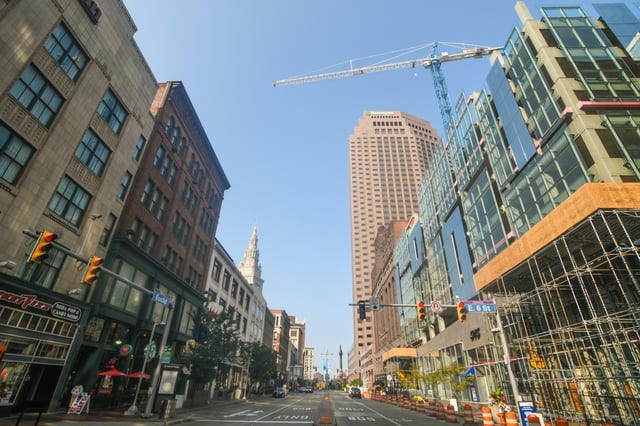
Euclid Avenue in 2017.
Cleveland's location on the Cuyahoga River and Lake Erie has been key to its growth.
The Ohio and Erie Canal coupled with rail links helped the city become an important business center. Steel and many other manufactured goods emerged as leading industries.[134] The city has since diversified its economy in addition to its manufacturing sector.
Established in 1914, the Federal Reserve Bank of Cleveland is one of 12 U.S. Federal Reserve Banks.[135] Its downtown building, located on East 6th Street and Superior Avenue, was completed in 1923 by the Cleveland architectural firm Walker and Weeks.[136] The headquarters of the Federal Reserve System's Fourth District, the bank employs 1,000 people and maintains branch offices in Cincinnati and Pittsburgh.[135]
The city is also home to the corporate headquarters of many large companies such as Applied Industrial Technologies, Cliffs Natural Resources, Forest City Enterprises, NACCO Industries, Sherwin-Williams Company, and KeyCorp. NASA maintains a facility in Cleveland, the Glenn Research Center. Jones Day, one of the largest law firms in the U.S., was founded in Cleveland.[137]
The Cleveland Clinic is the largest private employer in the city of Cleveland and the state of Ohio, with a workforce of over 50,000 as of 2019.[138] It carries the distinction as being among America's best hospitals with top ratings published in U.S. News & World Report.[139] Cleveland's healthcare sector also includes University Hospitals of Cleveland, MetroHealth medical center, and the insurance company Medical Mutual of Ohio. Cleveland is also noted in the fields of biotechnology and fuel cell research, led by Case Western Reserve University, the Cleveland Clinic, and University Hospitals of Cleveland. The city is among the top recipients of investment for biotech start-ups and research.[140]
Technology is another growing sector in Cleveland.
In 2005, the city appointed a "tech czar" to recruit technology companies to the downtown office market, offering connections to the high-speed fiber networks that run underneath downtown streets in several "high-tech offices" focused on Euclid Avenue.[141] Cleveland State University hired a technology transfer officer to cultivate technology transfers from CSU research to marketable ideas and companies in the Cleveland area. According to Forbes, Cleveland could be the next tech hub. 180 tech companies have started in the local area.[142] Local observers have noted that the city is transitioning from a manufacturing-based economy to a health-tech-based economy.[143]
Education
Primary and secondary education
The Cleveland Metropolitan School District is the second largest K–12 district in the state of Ohio. It is the only district in Ohio under direct control of the mayor, who appoints a school board.[144] Approximately 1 square mile (2.6 km2) of Cleveland, adjacent the Shaker Square neighborhood, is part of the Shaker Heights City School District. The area, which has been a part of the Shaker school district since the 1920s, permits these Cleveland residents to pay the same school taxes as the Shaker residents, as well as vote in the Shaker school board elections.[145]
Private and parochial schools within Cleveland proper include Benedictine High School, Birchwood School, Cleveland Central Catholic High School, Eleanor Gerson School, Montessori High School at University Circle, St. Ignatius High School, St. Joseph Academy, Villa Angela-St. Joseph High School, Urban Community School, St. Martin de Porres, and The Bridge Avenue School.[146]
Higher education
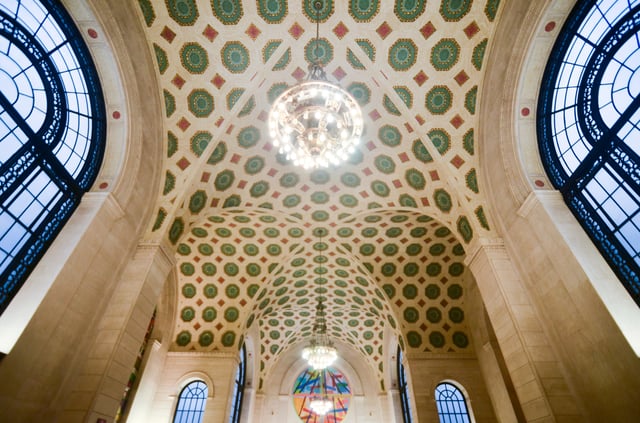
Interior of the 1925 main building of the Cleveland Public Library.
Cleveland is home to a number of colleges and universities.
Most prominent among these is Case Western Reserve University, a world-renowned research and teaching institution in University Circle. A private university with several prominent graduate programs, CWRU was ranked 42nd in the nation in 2019 by U.S. News & World Report.[147] University Circle also contains Cleveland Institute of Art and the Cleveland Institute of Music. Cleveland State University (CSU), based in Downtown Cleveland, is the city's public four-year university. In addition to CSU, downtown hosts the metropolitan campus of Cuyahoga Community College, the county's two-year higher education institution. Ohio Technical College is also based in Cleveland.[148] Cleveland's suburban universities and colleges include Baldwin Wallace University in Berea, John Carroll University in University Heights, Ursuline College in Pepper Pike, and Notre Dame College in South Euclid.[149]
Public library system
Established in 1869, the Cleveland Public Library is the third largest public library in the nation with a collection of 10,559,651 materials as of 2018.[150] Its John G. White Special Collection includes the largest chess library in the world as well as an impressive collection of folklore and rare books on the Middle East and Eurasia.[151][152][153] Under head librarian William Howard Brett, the library adopted an "open shelf" philosophy, which allowed patrons open access to the library's bookstacks.[154][155] Brett's successor, Linda Eastman, became the first woman ever to lead a major library system in the world.[156] She oversaw the construction of the library's main building on Superior Avenue, designed by Walker and Weeks and opened on May 6, 1925.[154] The Louis Stokes Wing addition was completed in April 1997.[154] Known as the "People's University," the library has 27 branches, including 15 built with funds from Andrew Carnegie.[150][154] It serves as the headquarters for the CLEVNET library consortium, which includes over 40 public library systems in the Greater Cleveland metropolitan area and Northeast Ohio.[157]
Culture
Performing arts
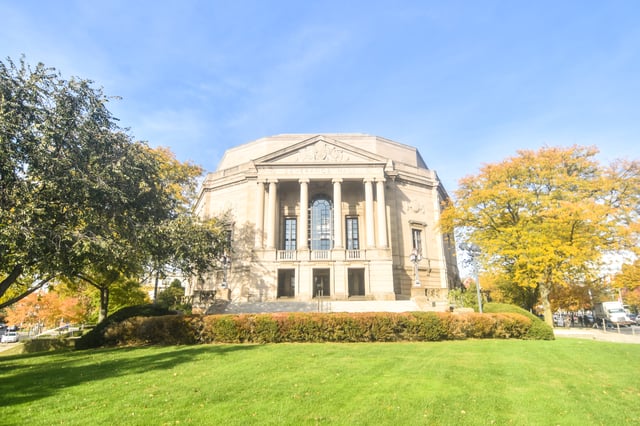
Severance Hall, home of the Cleveland Orchestra, in University Circle.
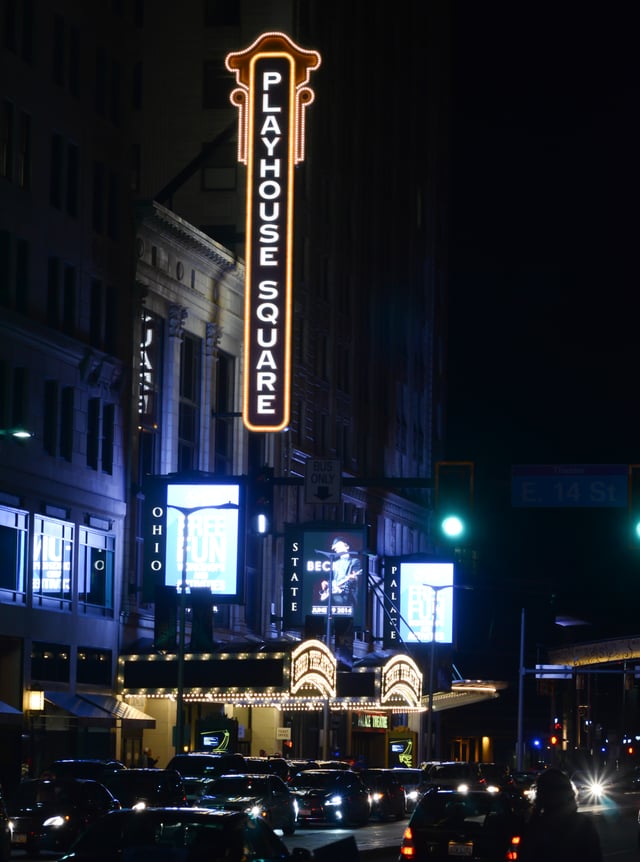
Cleveland's vibrant Playhouse Square is the second largest performing arts center in the U.S. after New York's Lincoln Center. It was also the city's main movie theater district during the Golden Age of Hollywood.[172]
Cleveland is home to Playhouse Square, the second largest performing arts center in the United States behind New York City's Lincoln Center.[158] Playhouse Square includes the State, Palace, Allen, Hanna, and Ohio theaters within what is known as the Cleveland Theater District.[159] Playhouse Square's resident performing arts companies include Cleveland Play House, Cleveland State University Department of Theatre and Dance, the Great Lakes Theater Festival, and the Cleveland Ballet.[160] The center hosts Broadway musicals, special concerts, speaking engagements, and other events throughout the year. A city with strong traditions in theater and vaudeville, Cleveland has produced many renowned actors and actresses, most prominently comedian Bob Hope.[161]
Outside Playhouse Square, Cleveland is home to Karamu House, the oldest African American theater in the nation, established in the 1920s.[162] On the West Side, the Gordon Square Arts District in Detroit-Shoreway is the location of the Capitol Theatre, the Near West Theatre, and an Off-Off-Broadway Playhouse, the Cleveland Public Theatre.[163] Cleveland's streetcar suburbs of Cleveland Heights, and Lakewood are home to the Dobama Theatre and the Beck Center for the Arts respectively.[162]
Cleveland is home to The Cleveland Orchestra, widely considered one of the world's finest orchestras, and often referred to as the finest in the nation.[164] It is one of the "Big Five" major orchestras in the United States.[165] The Orchestra plays at Severance Hall in University Circle during the winter and at Blossom Music Center in Cuyahoga Falls during the summer.[166] The city is also home to the Cleveland Pops Orchestra, the Cleveland Youth Orchestra, the Contemporary Youth Orchestra the Cleveland Youth Wind Symphony, and the biennial Cleveland International Piano Competition which has, in the past, often featured The Cleveland Orchestra.
One Playhouse Square, now the headquarters for Cleveland's public broadcasters, was initially used as the broadcast studios of WJW (AM), where disc jockey Alan Freed first popularized the term "rock and roll".[53] Cleveland gained a strong reputation in rock music in the 1960s and 1970s as a key breakout market for nationally promoted acts and performers.[167] Its popularity in the city was so great that Billy Bass, the program director at the WMMS radio station, referred to Cleveland as "The Rock and Roll Capital of the World."[167] From 1974 through 1980, the city hosted the World Series of Rock at Cleveland Municipal Stadium.[168]
Jazz has a long history in Cleveland.
Many major figures in jazz, including Louis Armstrong, Cab Calloway, Duke Ellington, Ella Fitzgerald, Dizzy Gillespie, Benny Goodman, and Billie Holiday performed in the city, and legendary pianist Art Tatum regularly played in Cleveland clubs during the 1930s.[40][41] Gypsy jazz guitarist Django Reinhardt gave his U.S. debut performance in Cleveland in 1946.[169] Prominent jazz artist Noble Sissle was a graduate of Cleveland Central High School, Artie Shaw worked and performed in Cleveland early in his career, and bandleader Phil Spitalny led his first orchestra in Cleveland. The Tri-C Jazz Fest has been held annually in Cleveland at Playhouse Square since 1979 and the Cleveland Jazz Orchestra was established in 1984.[40][41] Joe Siebert's documentary film The Sax Man on the life of Cleveland street saxophonist Maurice Reedus Jr. was released in 2014.[170]
The city also has a history of polka music being popular both past and present, even having a subgenre called Cleveland-style polka named after the city, and is home to the Polka Hall of Fame. This is due in part to the success of Frankie Yankovic who was a Cleveland native and was considered the America's Polka King and the square at the intersection of Waterloo Rd. and East 152nd St. in Cleveland (41°34′08″N 81°34′31″W [320] ), not far from where Yankovic grew up, was named in his honor.[171]
Film and television
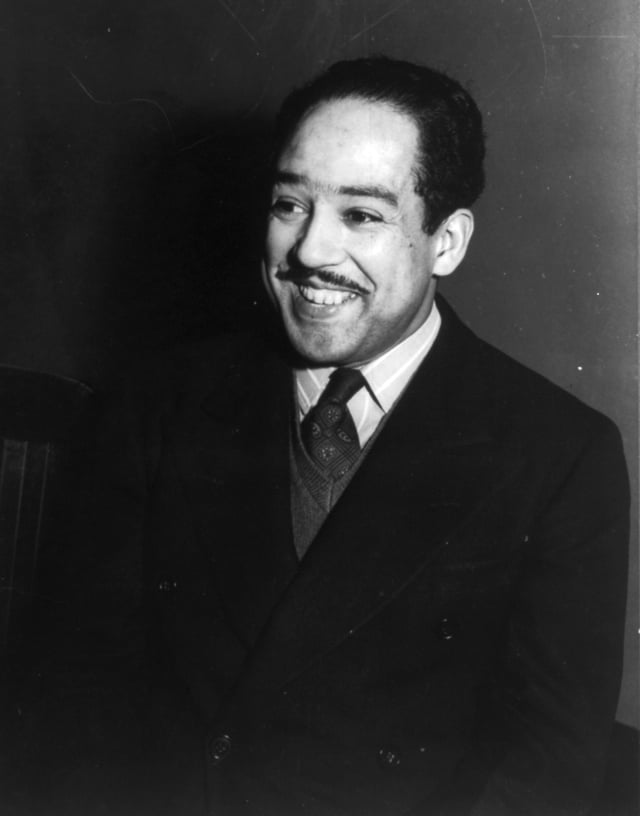
Jazz poet and resident Clevelander Langston Hughes.
Cleveland has served as the setting for many major studio and independent films. Reflecting its position as one of the largest American cities at the time, the city was referenced in numerous classic Hollywood movies, such as Howard Hawks' Ceiling Zero (1936) with James Cagney and Pat O'Brien, and Hobart Henley's romantic comedy The Big Pond (1930) with Maurice Chevalier and Claudette Colbert, which introduced the hit song "You Brought a New Kind of Love to Me".[173] Michael Curtiz's 1933 pre-Code classic Goodbye Again with Warren William and Joan Blondell was set in Cleveland. Players from the 1948 Cleveland Indians, winners of the World Series, appeared in The Kid from Cleveland (1949). Cleveland Municipal Stadium features prominently in both that film and The Fortune Cookie (1966). Written and directed by Billy Wilder, the latter marked Walter Matthau and Jack Lemmon's first on-screen collaboration and features gameday footage of the 1965 Cleveland Browns.[173]
Director Jules Dassin's first American film in nearly twenty years, Up Tight! (1968) is set in Cleveland immediately following the assassination of Martin Luther King, Jr. Set in 1930s Cleveland, Sylvester Stallone leads a local labor union in F.I.S.T. (1978). Paul Simon chose Cleveland as the opening for his only venture into filmmaking, One-Trick Pony (1980). He spent six weeks filming concert scenes at the Cleveland Agora. The boxing-match-turned-riot near the start of Raging Bull (1980) is set in the Cleveland Arena in 1941. Clevelander Jim Jarmusch's critically acclaimed independent film Stranger Than Paradise (1984)—a deadpan comedy about two New Yorkers who travel to Florida by way of Cleveland—was a favorite of the Cannes Film Festival, winning the Caméra d'Or. The cult-classic mockumentary This Is Spinal Tap (1984) includes a memorable scene where the parody band gets lost backstage just before performing at a Cleveland rock concert (origin of the phrase "Hello, Cleveland!"). Michael J. Fox and Joan Jett play the sibling leads of a Cleveland rock group in Light of Day (1987); directed by Paul Schrader, much of the film was shot in the city.[173][174]
Both Major League (1989) and Major League II (1994) reflected the actual perennial struggles of the Cleveland Indians during the 1960s, 1970s, and 1980s. Kevin Bacon stars in Telling Lies in America (1997), the semi-autobiographical tale of Clevelander Joe Eszterhas, a former reporter for The Plain Dealer. A group of Cleveland teenagers try to scam their way into a Kiss concert in Detroit Rock City (1999), and several key scenes from director Cameron Crowe's Almost Famous (2000) are set in Cleveland. Antwone Fisher (2002) recounts the real-life story of the Cleveland native. Brothers Joe and Anthony Russo—native Clevelanders and Case Western Reserve University alumni—filmed their comedy Welcome to Collinwood (2002) entirely on location in the city. American Splendor (2003)—the biographical film of Harvey Pekar, author of the autobiographical comic of the same name—was also filmed on location throughout Cleveland, as was The Oh in Ohio (2006). Much of The Rocker (2008) is set in the city, and Cleveland native Nathaniel Ayers' life story is told in The Soloist (2009). Kill the Irishman (2011) follows the real-life turf war in 1970s Cleveland between Irish mobster Danny Greene and the Cleveland crime family. More recently, the teenage comedy Fun Size (2012) takes place in and around Cleveland on Halloween night, and the film Draft Day (2014) followed Kevin Costner as general manager for the Cleveland Browns.[173][174][175][176]
Cleveland has often doubled for other locations in the film.
The wedding and reception scenes in The Deer Hunter (1978), while set in the small Pittsburgh suburb of Clairton, were shot in the Cleveland neighborhood of Tremont; U.S. Steel also permitted the production to film in one of its Cleveland mills. Francis Ford Coppola produced The Escape Artist (1982), much of which was shot in Downtown Cleveland near City Hall and the Cuyahoga County Courthouse, as well as the Flats. A Christmas Story (1983) was set in Indiana, but drew many of its external shots—including the Parker family home—from Cleveland. Cleveland serves as the setting for fictitious insurance giant Great Benefit in The Rainmaker (1997); in the film, Key Tower doubles as the firm's main headquarters. The opening shots of Air Force One (1997) were filmed in and above Severance Hall. A complex chase scene in Spider-Man 3 (2007), though set in New York City, was filmed along Cleveland's Euclid Avenue. Downtown's East 9th Street also doubled for New York in the climax of The Avengers (2012); in addition, the production shot on Cleveland's Public Square as a fill-in for Stuttgart, Germany. More recently, Jackass Presents: Bad Grandpa (2013), Miss Meadows (2014) and Captain America: The Winter Soldier (2014) each filmed in Cleveland. Future productions in the Cleveland area are the responsibility of the Greater Cleveland Film Commission.[173][174][177]
In television, the city is the setting for the popular network sitcom The Drew Carey Show, starring Cleveland native Drew Carey.[178] Hot in Cleveland, a comedy airing on TV Land, premiered on June 16, 2010 and ran for six seasons until its finale on June 3, 2015.[179][180] Later episodes of the reality show Keeping Up With the Kardashians have been partially filmed in Cleveland, after series star Khloe Kardashian began a relationship with Cleveland Cavaliers center Tristan Thompson.[181] Cleveland Hustles, the CNBC reality show co-created by LeBron James, was filmed in the city.[163]
Literature
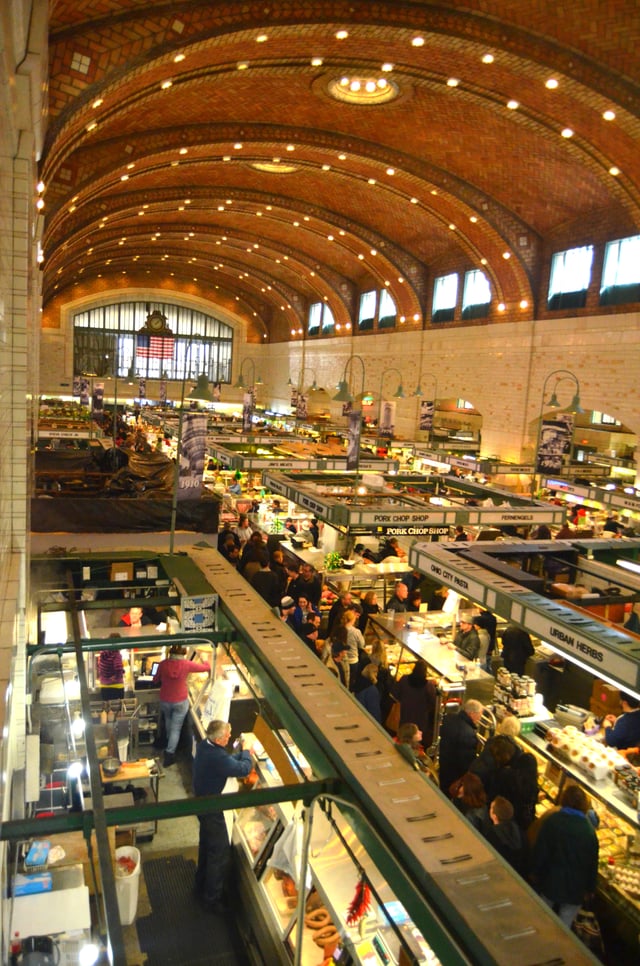
The historic West Side Market in Cleveland's Ohio City neighborhood.
The American modernist poet Hart Crane was born in nearby Garrettsville, Ohio in 1899. His adolescence was divided between Cleveland and Akron before he moved to New York City in 1916. Aside from factory work during the first world war, he served as reporter to The Plain Dealer for a short period, before achieving recognition in the Modernist literary scene. A diminutive memorial park is dedicated to Crane along the left bank of the Cuyahoga in Cleveland. In University Circle, a historical marker sits at the location of his Cleveland childhood house on E. 115 near the Euclid Avenue intersection. On Case Western Reserve University campus, a statue of him stands behind the Kelvin Smith Library.
Langston Hughes, preeminent poet of the Harlem Renaissance and child of an itinerant couple, lived in Cleveland as a teenager and attended Central High School in Cleveland in the 1910s.[182] At Central High, Hughes was taught by Helen Maria Chesnutt, daughter of renowned Cleveland-born African American novelist Charles W. Chesnutt.[183] He also wrote for the school newspaper and started writing his earlier plays, poems and short stories while living in Cleveland.[182] The African American avant-garde poet Russell Atkins also lived in Cleveland.[184]
Harlan Ellison, noted author of speculative fiction, was born in Cleveland in 1934; his family subsequently moved to the nearby town of Painesville, though Ellison moved back to Cleveland in 1949. As a youngster, he published a series of short stories appearing in the Cleveland News; he also performed in a number of productions for the Cleveland Play House.
Cleveland is the site of the Anisfield-Wolf Book Award, established by poet and philanthropist Edith Anisfield Wolf in 1935, which recognizes books that have made important contributions to understanding of racism and human diversity.[190] Presented by the Cleveland Foundation, it remains the only American book prize focusing on works that address racism and diversity.[191] In an early Gay and lesbian studies anthology titled Lavender Culture,[192] a short piece by John Kelsey "The Cleveland Bar Scene in the Forties" discusses the gay and lesbian culture in Cleveland and the unique experiences of amateur female impersonators that existed alongside the New York and San Francisco LGBT subcultures.[193]
Cuisine
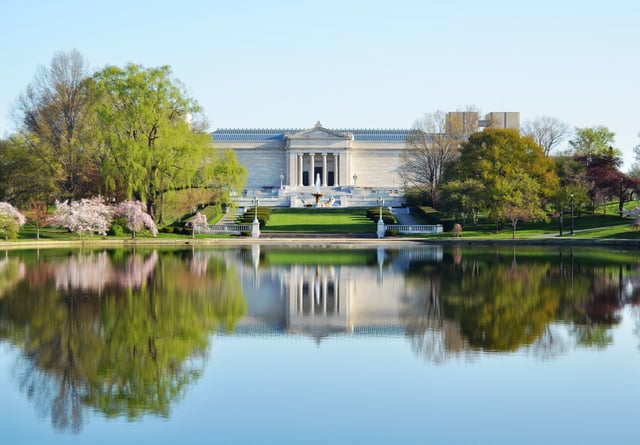
The Cleveland Museum of Art lies at the edge of Wade Lagoon in University Circle.
Cleveland's mosaic of ethnic communities and their various culinary traditions have long played an important role in defining the local cuisine.
Examples of these can particularly be found in neighborhoods such as Little Italy, Slavic Village, and Tremont.
Local mainstays of Cleveland's cuisine include an abundance of Polish and Central European contributions, such as kielbasa, stuffed cabbage and pierogies.[194] Cleveland also has plenty of corned beef, with nationally renowned Slyman's, on the near East Side, a perennial winner of various accolades from Esquire Magazine, including being named the best corned beef sandwich in America in 2008.[195] Other famed sandwiches include the Cleveland original, Polish Boy, a local favorite found at many BBQ and Soul food restaurants.[194][196] With its blue-collar roots well intact, and plenty of Lake Erie perch available, the tradition of Friday night fish fries remains alive and thriving in Cleveland, particularly in church-based settings and during the season of Lent.[197] Ohio City is home to a growing brewery district, which includes Great Lakes Brewing Company (Ohio's oldest microbrewery); Market Garden Brewery next to the historic West Side Market and Platform Beer Company.[198]
Cleveland is noted in the world of celebrity food culture.
Famous local figures include chef Michael Symon and food writer Michael Ruhlman, both of whom achieved local and national attentions for their contributions in the culinary world. On November 11, 2007, Symon helped gain the spotlight when he was named "The Next Iron Chef" on the Food Network. In 2007, Ruhlman collaborated with Anthony Bourdain, to do an episode of his Anthony Bourdain: No Reservations focusing on Cleveland's restaurant scene.[199]
The national food press—including publications Gourmet, Food & Wine, Esquire and Playboy—has heaped praise on several Cleveland spots for awards including 'best new restaurant', 'best steakhouse', 'best farm-to-table programs' and 'great new neighborhood eateries'. In early 2008, the Chicago Tribune ran a feature article in its 'Travel' section proclaiming Cleveland, America's "hot new dining city".[199] In 2015, the city was named the 7th best food city in the nation by Time magazine.[200]
Museums and tourism
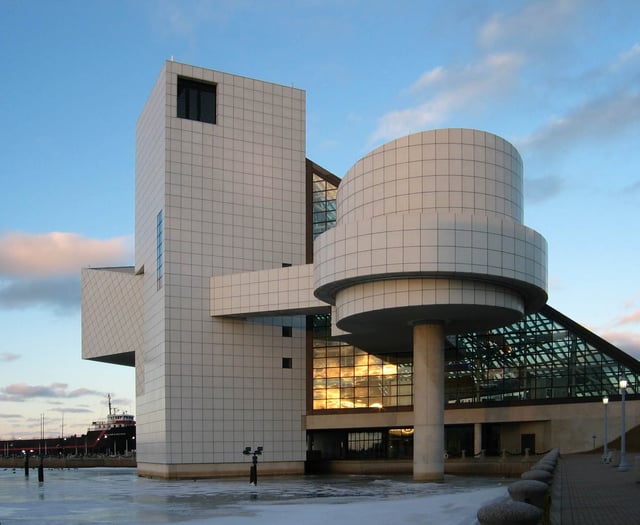
The Rock and Roll Hall of Fame on the shores of Lake Erie.
There are two main art museums in Cleveland. The Cleveland Museum of Art is a major American art museum, with a collection that includes more than 40,000 works of art ranging over 6,000 years, from ancient masterpieces to contemporary pieces.[201] The Museum of Contemporary Art Cleveland showcases established and emerging artists, particularly from the Cleveland area, through hosting and producing temporary exhibitions.[202] Both museums offer free admission to visitors, with the Cleveland Museum of Art declaring their museum free and open "for the benefit of all the people forever."[24][201][202]
Both museums are also part of Cleveland's University Circle, a 550-acre (2.2 km2) concentration of cultural, educational, and medical institutions located 5 miles (8.0 km) east of downtown.
In addition to the art museums, the neighborhood also includes the Cleveland Botanical Garden, Case Western Reserve University, University Hospitals, Severance Hall, the Cleveland Museum of Natural History, and the Western Reserve Historical Society. Also located at University Circle is the Cleveland Cinematheque at the Cleveland Institute of Art, hailed by The New York Times as one of the country's best alternative movie theaters.[203] Cleveland is home to the I. M. Pei-designed Rock and Roll Hall of Fame on the Lake Erie waterfront at North Coast Harbor downtown. Neighboring attractions include Cleveland Browns Stadium, the Great Lakes Science Center, the Steamship Mather Museum, and the USS Cod, a World War II submarine. Located at Public Square, the Soldiers' and Sailors' Monument is Cleveland's major Civil War memorial and a major attraction in the city.[204] Other city attractions include the Lorenzo Carter Cabin, the Grays Armory, the Cleveland Police Museum, and the Federal Reserve Bank of Cleveland's Money Museum.[14][205][206][207]
The Cleveland International Film Festival has been held annually since 1977, and it drew a record 106,000 people in 2017.[208] Fashion Week Cleveland, the city's annual fashion event, is the third-largest fashion show of its kind in the United States.[209] The Cleveland National Air Show, an indirect successor to the National Air Races, has been annually held at the city's Burke Lakefront Airport since 1964.[210] Sponsored by the Great Lakes Brewing Company, the Great Lakes Burning River Fest, a two-night music and beer festival at Whiskey Island, has been held annually since 2001.[211] Proceeds from that festival benefit the Burning River Foundation, a local non-profit dedicated to "improving, maintaining and celebrating the vitality of [Cleveland's] regional freshwater resources."[212] Cleveland also hosts an annual holiday display lighting and celebration, dubbed Winterfest, which is held downtown at the city's historic hub, Public Square.[213] Another Cleveland holiday attraction, especially for fans of Jean Shepherd's A Christmas Story, is the Christmas Story House and Museum in Tremont.[214] Cleveland is also home to the Jack Cleveland Casino in the historic former Higbee's Building at Tower City Center.
Sports
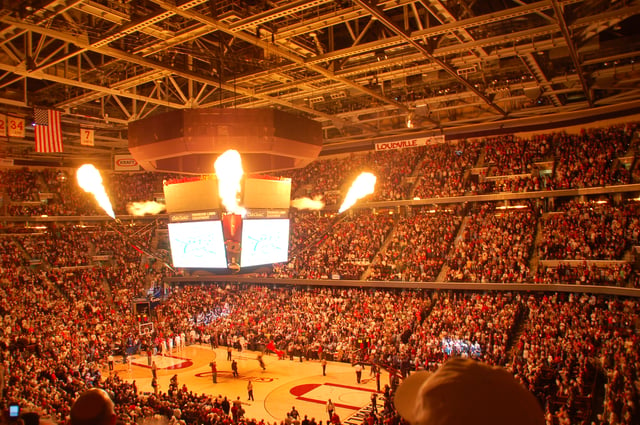
Cleveland Cavaliers pregame festivities at Rocket Mortgage FieldHouse.
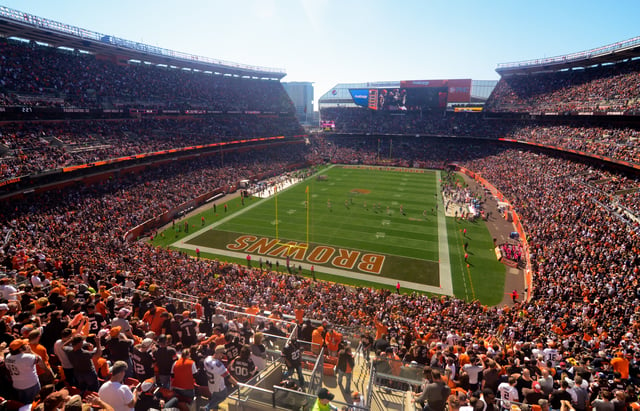
Cleveland Browns games attract large crowds to FirstEnergy Stadium.
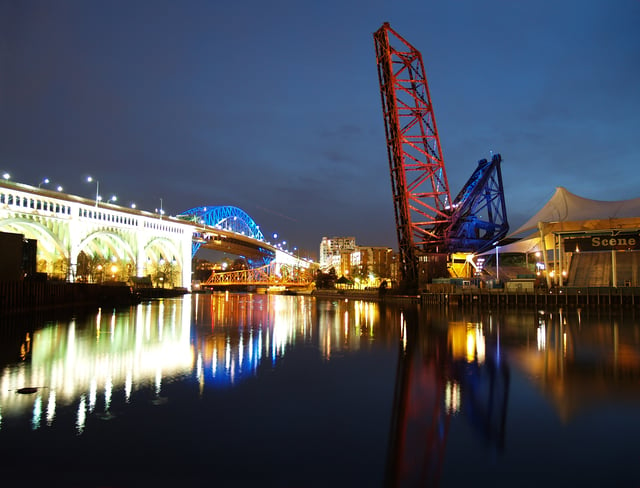
The west bank of the Flats and the Cuyahoga River in Downtown Cleveland.
Cleveland's current major professional sports teams include the Cleveland Indians (Major League Baseball), Cleveland Browns (National Football League), and Cleveland Cavaliers (National Basketball Association). Local sporting facilities include Progressive Field, FirstEnergy Stadium, Rocket Mortgage FieldHouse, and the Wolstein Center. The city is also host to the Cleveland Monsters of the American Hockey League, who won the 2016 Calder Cup, the first Cleveland AHL team to do so since the 1964 Barons.[215] Other professional teams in the city include the Cleveland Gladiators of the Arena Football League, Cleveland Fusion of the Women's Football Alliance, and Cleveland SC of the National Premier Soccer League.
The Cleveland Indians won the World Series in 1920 and 1948. They also won the American League pennant, making the World Series in the 1954, 1995, 1997, and 2016 seasons. Between 1995 and 2001, Progressive Field (then known as Jacobs Field) sold out 455 consecutive games, a Major League Baseball record until it was broken in 2008.[216]
Historically, the Browns have been among the most successful franchises in American football history, winning eight titles during a short period of time—1946, 1947, 1948, 1949, 1950, 1954, 1955, and 1964. The Browns have never played in a Super Bowl, getting close five times by making it to the NFL/AFC Championship Game in 1968, 1969, 1986, 1987, and 1989. Former owner Art Modell's relocation of the Browns after the 1995 season (to Baltimore creating the Ravens), caused tremendous heartbreak and resentment among local fans.[217] Cleveland mayor, Michael R. White, worked with the NFL and Commissioner Paul Tagliabue to bring back the Browns beginning in the 1999 season, retaining all team history.[218] In Cleveland's earlier football history, the Cleveland Bulldogs won the NFL Championship in 1924, and the Cleveland Rams won the NFL Championship in 1945 before relocating to Los Angeles.
The Cavaliers won the Eastern Conference in 2007, 2015, 2016, 2017 and 2018 but were defeated in the NBA Finals by the San Antonio Spurs and then by the Golden State Warriors, respectively. The Cavs won the Conference again in 2016 and won their first NBA Championship coming back from a 3–1 deficit, finally defeating the Golden State Warriors. Afterwards, an estimated 1.3 million people attended a parade held in the Cavs honor on June 22, 2016. This was the first time the city had planned for a championship parade in 50 years.[219] Basketball, the Cleveland Rosenblums dominated the original American Basketball League winning three of the first five championships (1926, 1929, 1930), and the Cleveland Pipers, owned by George Steinbrenner, won the American Basketball League championship in 1962.
Jesse Owens grew up in Cleveland after moving from Alabama when he was nine. He participated in the 1936 Summer Olympics in Berlin, where he achieved international fame by winning four gold medals. A statue commemorating his achievement can be found in Downtown Cleveland at Fort Washington Park.[220] A statue of another famous Cleveland athlete, Irish-American World Featherweight boxing champion Johnny Kilbane, stands in the city's Battery Park on the West Side.[221]
Cleveland State University alum and area native, Stipe Miocic, won the UFC World Heavyweight Championship at UFC 198 in 2016. Miocic has defended his World Heavyweight Champion title at UFC 203, the first ever UFC World Championship fight held in the city of Cleveland,[222] and again at UFC 211 and UFC 220. After losing it in 2018, Miocic regained the world title at UFC 241.
Collegiately, NCAA Division I Cleveland State Vikings have 16 varsity sports, nationally known for their Cleveland State Vikings men's basketball team. NCAA Division III Case Western Reserve Spartans have 19 varsity sports, most known for their Case Western Reserve Spartans football team. The headquarters of the Mid-American Conference (MAC) are in Cleveland. The conference also stages both its men's and women's basketball tournaments at Quicken Loans Arena.
Several chess championships have taken place in Cleveland.
The second American Chess Congress, a predecessor the current U.S. Championship, was held in 1871, and won by George Henry Mackenzie. The 1921 and 1957 U.S. Open Chess Championship also took place in the city, and were won by Edward Lasker and Bobby Fischer, respectively. The Cleveland Open is held annually.
The Cleveland Marathon has been hosted annually since 1978.
Environment
With its extensive cleanup of the Cuyahoga River and its portion of Lake Erie, Cleveland has been recognized by national media as an environmental success story and a national leader in environmental protection.[65] In 2019, the American Rivers conservation association named the Cuyahoga River "River of the Year" in honor of "50 years of environmental resurgence."[55] In addition to continued efforts to improve freshwater and air quality, the city is now exploring renewable energy. Cleveland's two main electrical utilities are FirstEnergy and Cleveland Public Power. Its climate action plan, updated in December 2018, has a 2050 target of 100 percent renewable power, along with reduction of greenhouse gases to 80 percent below the 2010 level.[223]
Government and politics
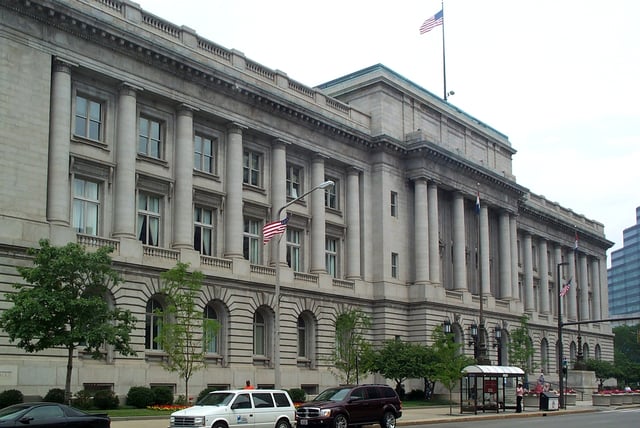
Cleveland City Hall.
Cleveland operates on a mayor–council (strong mayor) form of government, in which the mayor is the chief executive. From 1924 to 1931, the city briefly experimented with a council–manager government under William R. Hopkins and Daniel E. Morgan before returning to the mayor–council system.[224]
The office of the mayor has been held by Frank G. Jackson since 2006. Previous mayors of Cleveland include progressive Democrat Tom L. Johnson, World War I-era War Secretary and BakerHostetler founder Newton D. Baker, U.S. Supreme Court Justice Harold Hitz Burton, two-term Ohio Governor and Senator Frank J. Lausche, former U.S. Health, Education, and Welfare Secretary Anthony J. Celebrezze, two-term Ohio Governor and Senator George V. Voinovich, former U.S. Congressman Dennis Kucinich, and Carl B. Stokes, the first African American mayor of a major U.S. city.[58]
From the Civil War era to the 1940s, Cleveland was primarily dominated by the Republican Party, with the notable exceptions of the Johnson and Baker mayoral administrations.[224] Businessman and Senator Mark Hanna was among Cleveland's most influential Republican figures, both locally and nationally.[227] In addition to the established support of organized labor, the Cuyahoga County Democratic Party, led by former mayor Ray T. Miller, was able to secure the support of the city's ethnic European and African American communities in the 1940s.[224] Beginning with the Lausche administration, Cleveland's political orientation shifted to the Democratic Party and, with the exceptions of the Perk and Voinovich administrations, it has remained dominated by the Democrats ever since.[224]
Today, while other parts of Ohio, particularly Cincinnati and the southern portion of the state, support the Republicans, Cleveland commonly produces the strongest support in the state for the Democrats.[228] At the local level, elections are nonpartisan. However, Democrats still dominate every level of government. During the 2004 Presidential election, although George W. Bush carried Ohio by 2.1%, John Kerry carried Cuyahoga County 66.6%–32.9%, his largest margin in any Ohio county.[229] The city of Cleveland supported Kerry over Bush by the even larger margin of 83.3%–15.8%.[230] As a result of the 2010 Census, Ohio lost two Congressional seats, which affected Cleveland's districts in the northeast part of the state.[231] Today, Cleveland is split between two congressional districts. Most of the western part of the city is in the 9th District, represented by Marcy Kaptur. Most of the eastern part of the city, as well as most of downtown, is in the 11th District, represented by Marcia Fudge. Both are Democrats, two of four representing the state of Ohio.
Cleveland hosted three Republican national conventions in its history, in 1924, 1936, and 2016.[232] The city also hosted the Radical Republican convention of 1864.[233] Cleveland has not hosted a national convention for the Democrats, despite the position of Cuyahoga County as a Democratic stronghold in Ohio.
Public safety
Police and law enforcement
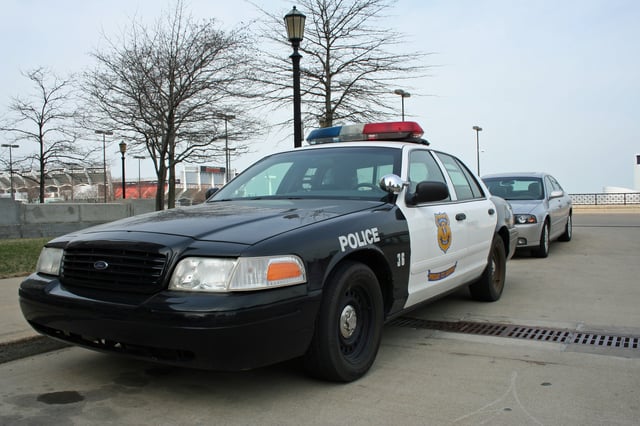
A Cleveland Police black and white parked outside of Cleveland City Hall.
Like in other major American cities, crime in Cleveland is concentrated in areas with higher rates of poverty and lower access to jobs.[236][237] In recent years, the rate of crime in the city has seen a significant decline, following a nationwide trend in falling crime rates.[236] Cleveland Police statistics published in 2019 showed that rates for violent crimes and property crimes in Cleveland dropped substantially in 2018. The rate of property crimes specifically fell by 30% since 2016.[238]
Cleveland's law enforcement agency is the Cleveland Division of Police, established in 1866.[239][240] The division has 1,444 sworn officers as of 2016.[241] Cleveland has five police districts.[242] The district system was introduced in the 1930s by Cleveland Public Safety Director Eliot Ness (of the Untouchables), who later ran for mayor of Cleveland in 1947.[239][243] The division has been recognized for several "firsts," including the "first criminal conviction secured by matching a palm print lifted from a crime scene to a suspect."[240] The current Chief of Police is Calvin D. Williams.[244]
Consent decree with Department of Justice
In December 2014, the United States Department of Justice announced the findings of a two-year investigation, prompted by a request from Mayor Frank Jackson, to determine whether the Cleveland Police engaged in a pattern of excessive force.[245] After reviewing nearly 600 use-of-force incidents from 2010 to 2013, the investigators found systemic patterns, insufficient accountability mechanisms, inadequate training, ineffective policies, and inadequate community engagement.[246][247] As a result of the Justice Department report, the city agreed to a consent decree to revise its policies and implement new independent oversight over the police force.[248]
The consent decree, released on May 26, 2015, mandates sweeping changes in training for recruits and seasoned officers, developing programs to identify and support troubled officers, updating technology and data management practices, and an independent monitor to ensure the decree's goals are met.[249] At least some of the provisions have been identified as unique to Cleveland.[250][251] On June 12, 2015, Chief U.S. District Judge Solomon Oliver Jr. approved and signed the consent decree, beginning the process of police reform.[252]
Fire department
Cleveland is served by the firefighters of the Cleveland Division of Fire, established in 1863.[253] The fire department operates out of 22 active fire stations throughout the city in five battalions. Each Battalion is commanded by a Battalion Chief, who reports to an on-duty Assistant Chief.[254][255]
The Division of Fire operates a fire apparatus fleet of twenty-two engine companies, eight ladder companies, three tower companies, two task force rescue squad companies, hazardous materials ("haz-mat") unit, and numerous other special, support, and reserve units. The current Chief of Department is Angelo Calvillo.[256]
Emergency Medical Services
Cleveland EMS is operated by the city as its own municipal third-service EMS division.
Cleveland EMS is the primary provider of Advanced Life Support and ambulance transport within the city of Cleveland, while Cleveland Fire assists by providing fire response medical care.[257] Although a merger between the fire and EMS departments was proposed in the past, the idea was subsequently abandoned.[258]
Media
Print
Cleveland's primary daily newspaper is The Plain Dealer. Defunct major newspapers include the Cleveland Press, an afternoon publication which printed its last edition on June 17, 1982; and the Cleveland News, which ceased publication in 1960. Additional newspapers include: The Morning Journal, which serves suburbs bordering directly on the western Cleveland border; the News-Herald which serves the smaller suburbs in the East Side; the Thursdays-only Sun Post-Herald, which serves a few neighborhoods on the city's West Side; and the Call and Post, a weekly newspaper that primarily serves the city's African American community. The city is also served by Cleveland Magazine, a regional culture magazine published monthly; Crain's Cleveland Business, a weekly business newspaper; Cleveland Jewish News, a weekly Jewish newspaper; and Cleveland Scene, a free alternative weekly paper which absorbed its competitor, the Cleveland Free Times, in 2008.[259][260][261] In addition, nationally distributed rock magazine Alternative Press was founded in Cleveland in 1985, and the publication's headquarters remain in the city.[262][263][264] The digital Belt Magazine was founded in Cleveland in 2013.[265] Time magazine was published in Cleveland for a brief period from 1925 to 1927.[266]
Television
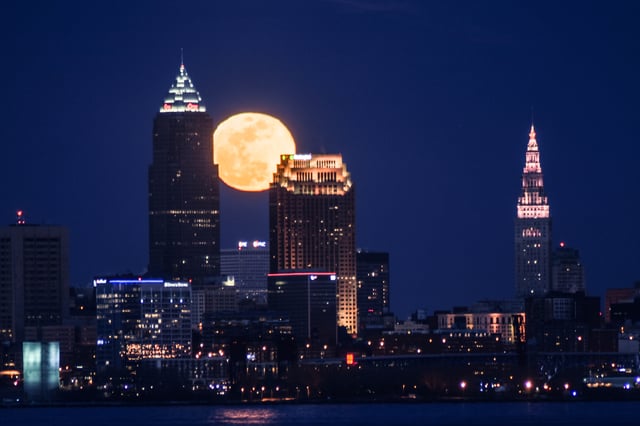
Moon over Downtown Cleveland.
Combined with nearby Akron and Canton, Cleveland is ranked as the 19th-largest television market by Nielsen Media Research (as of 2013–14).[267] The market is served by 10 full power stations, including: WEWS-TV (ABC), WJW (Fox), WKYC (NBC), WOIO (CBS), WVIZ (PBS), WUAB (The CW), WVPX-TV (Ion), WQHS-DT (Univision), WDLI-TV (Ion Plus), and the independent WBNX-TV.[268]
The Mike Douglas Show, a nationally syndicated daytime talk show, began in Cleveland in 1961 on KYW-TV (now WKYC), while The Morning Exchange on WEWS-TV served as the model for Good Morning America.[269][270] Tim Conway and Ernie Anderson first established themselves in Cleveland while working together at KYW-TV and later WJW-TV (now WJW). Anderson both created and performed as the immensely popular Cleveland horror host Ghoulardi on WJW-TV's Shock Theater, and was later succeeded by the long-running late night duo Big Chuck and Lil' John.[271]
Radio
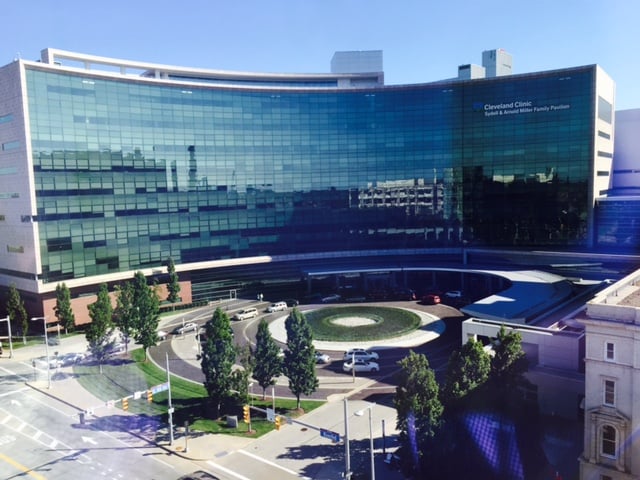
Cleveland Clinic Miller Family Pavilion.
Cleveland is directly served by 31 AM and FM radio stations, 22 of which are licensed to the city. Commercial FM music stations are frequently the highest rated stations in the market: WAKS (contemporary hit radio), WDOK (adult contemporary), WENZ (mainstream urban), WGAR-FM (country), WHLK (adult hits), WMJI (classic hits), WMMS (active rock/hot talk), WNCX (classic rock), WNWV (smooth jazz), WQAL (hot adult contemporary), and WZAK (urban adult contemporary).[272][273] WCPN public radio functions as the local NPR affiliate, and sister station WCLV airs a classical music format.[274] College radio stations include WBWC (Baldwin Wallace University), WCSB (Cleveland State University), WJCU (John Carroll University), and WRUW-FM (Case Western Reserve University).[272]
News/talk station WTAM serves as the AM flagship for both the Cleveland Cavaliers and Cleveland Indians.[275][276] WKNR and WWGK cover sports via ESPN Radio, while WKRK-FM covers sports via CBS Sports Radio (WKNR and WKRK-FM are also co-flagship stations for the Cleveland Browns).[277][278][279] As WJW (AM), WKNR was once the home of Alan Freed − the Cleveland disc jockey credited with first using and popularizing the term "rock and roll" to describe the music genre.[53][167] News/talk station WHK was one of the first radio stations to broadcast in the United States and the first in Ohio.[280][281] Its former sister station, rock station WMMS, dominated Cleveland radio in the 1970s and 1980s and was at that time one of the highest rated radio stations in the country. In 1972, WMMS program director Billy Bass coined the phrase "The Rock and Roll Capital of the World" to describe Cleveland. In 1987, Playboy named WMMS DJ Kid Leo (Lawrence Travagliante) "The Best Disc Jockey in the Country".[282][283][284]
Healthcare
Cleveland is home to a number of leading hospital systems, several of which are in University Circle. Most notable is the world-renowned Cleveland Clinic, which is supplemented by University Hospitals and its Rainbow Babies & Children's Hospital. On the city's West Side is the main campus of the MetroHealth System, which operates a level one trauma center in northeast Ohio, and has various locations throughout greater Cleveland.[285] Cleveland's Global Center for Health Innovation opened with 235,000 square feet (21,800 m2) of display space for healthcare companies across the world. To take advantage of the proximity of universities and other medical centers in Cleveland, the Veterans Administration moved the regions VA hospital from suburban Brecksville to a new facility in University Circle.
Transportation
Walkability
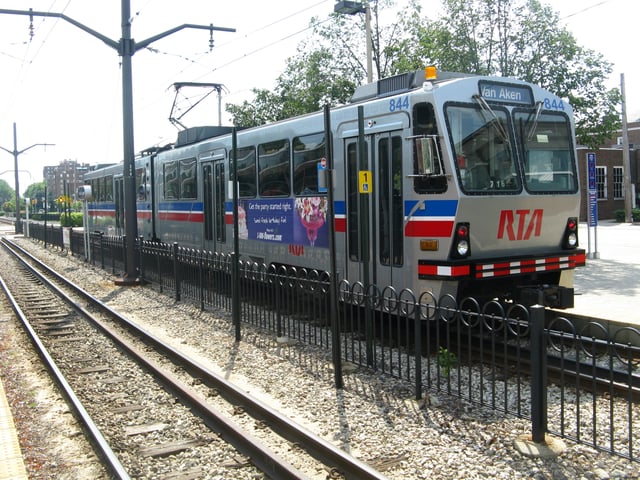
An RTA train arrives at the Shaker Square station.
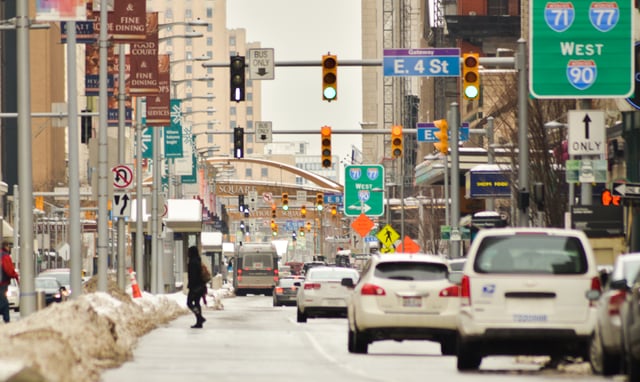
Streets of Cleveland.
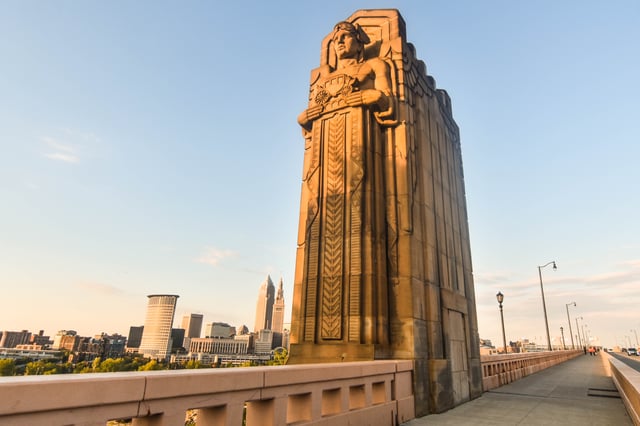
One of the "Guardians of Traffic" at the Hope Memorial Bridge.
In 2011, Walk Score ranked Cleveland the seventeenth most walkable of the fifty largest cities in the United States.[286] As of 2014, Walk Score increased Cleveland's rank to being the sixteenth most walkable US city, with a Walk Score of 57, a Transit Score of 47, and a Bike Score of 51. Cleveland's most walkable and transient areas can be found in the Downtown, Ohio City, Detroit-Shoreway, University Circle, and Buckeye-Shaker Square neighborhoods.[287]
Urban transit systems
Cleveland has a bus and rail mass transit system operated by the Greater Cleveland Regional Transit Authority (RTA). The rail portion is officially called the RTA Rapid Transit, but local residents refer to it as The Rapid. It consists of four light rail lines, known as the Blue, Green, and Waterfront lines, and a heavy rail line, the Red Line. In 2008, RTA completed the HealthLine, a bus rapid transit line, for which naming rights were purchased by the Cleveland Clinic and University Hospitals. It runs along Euclid Avenue from downtown through University Circle, ending at the Louis Stokes Station at Windermere in East Cleveland.[288] In 1968, Cleveland became the first city in the nation to have a direct rail transit connection linking the city's downtown to its major airport.[49] In 2007, the American Public Transportation Association named Cleveland's mass transit system the best in North America.[289] Cleveland is the only metropolitan area in the Western Hemisphere with its rail rapid transit system having only one center-city area rapid transit station (Tower City-Public Square).
Private automobiles
The city of Cleveland has a higher than average percentage of households without a car.
In 2016, 23.7 percent of Cleveland households lacked a car, while the national average was 8.7 percent.
Cleveland averaged 1.19 cars per household in 2016, compared to a national average of 1.8.[290]
Roads
Cleveland's road system consists of numbered streets running roughly north–south, and named avenues, which run roughly east–west.
The numbered streets are designated "east" or "west", depending where they lie in relation to Ontario Street, which bisects Public Square.[291] The numbered street system extends beyond the city limits into some suburbs on both the West and East Sides. The named avenues that lie both on the east side of the Cuyahoga River and west of Ontario Street receive a "west" designation on street signage. The two downtown avenues which span the Cuyahoga change names on the west side of the river. Superior Avenue becomes Detroit Avenue on the West Side, and Carnegie Avenue becomes Lorain Avenue. The bridges that make these connections are often called the Detroit–Superior Bridge and the Lorain–Carnegie Bridge.
Freeways
Three two-digit Interstate highways serve Cleveland directly. Interstate 71 begins just southwest of downtown and is the major route from downtown Cleveland to the airport. I-71 runs through the southwestern suburbs and eventually connects Cleveland with Columbus and Cincinnati. Interstate 77 begins in downtown Cleveland and runs almost due south through the southern suburbs. I-77 sees the least traffic of the three interstates, although it does connect Cleveland to Akron. Interstate 90 connects the two sides of Cleveland, and is the northern terminus for both I-71 and I-77. Running due east–west through the West Side suburbs, I-90 turns northeast at the junction with and I-490, and is known as the Innerbelt through downtown. At the junction with the Shoreway, I-90 makes a 90-degree turn known in the area as Dead Man's Curve, then continues northeast, entering Lake County near the eastern split with Ohio State Route 2. Cleveland is also served by two three-digit interstates, Interstate 480, which enters Cleveland briefly at a few points and Interstate 490, which connects I-77 with the junction of I-90 and I-71 just south of downtown.[292]
Two other limited-access highways serve Cleveland.
The Cleveland Memorial Shoreway carries State Route 2 along its length, and at varying points also carries US 6, US 20 and I-90. The Jennings Freeway (State Route 176) connects I-71 just south of I-90 to I-480 near the suburbs of Parma and Brooklyn Heights. A third highway, the Berea Freeway (State Route 237 in part), connects I-71 to the airport, and forms part of the boundary between Cleveland and Brook Park.[293]
Airports

1992 aerial view of the Cleveland harbor, with the mouth of the Cuyahoga River in the foreground (view towards the east).
Cleveland Hopkins International Airport is the city's major airport and an international airport that once served as a main hub for United Airlines and Continental Airlines. It holds the distinction of having the first airport-to-downtown rapid transit connection in North America, established in 1968. In 1930, the airport was the site of the first airfield lighting system and the first air traffic control tower. Originally known as Cleveland Municipal Airport, it was the first municipally owned airport in the country. Cleveland Hopkins is a significant regional air freight hub hosting FedEx Express, UPS Airlines, United States Postal Service, and major commercial freight carriers. In addition to Hopkins, Cleveland is served by Burke Lakefront Airport, on the north shore of downtown between Lake Erie and the Shoreway. Burke is primarily a commuter and business airport.[294]
Seaport
The Port of Cleveland, at the Cuyahoga River's mouth, is a major bulk freight terminal on Lake Erie, receiving much of the raw materials used by the region's manufacturing industries.[295]
Railroads
Cleveland has a long rich history as a major railroad hub in the United States.
Today, Amtrak, the national passenger rail system, provides service to Cleveland, via the Capitol Limited and Lake Shore Limited routes, which stop at Cleveland Lakefront Station. Additionally, Cleveland hosts several inter-modal freight railroad terminals.[296][297] There have been several proposals for commuter rail in Cleveland, including a study into a Sandusky–Cleveland line.[298][299] Cleveland was also identified as a hub for the now-suspended Ohio Hub project, which would bring high-speed rail to Ohio.[300]
Inter-city bus lines
National intercity bus service is provided at a Greyhound station, just behind the Playhouse Square theater district. Megabus provides service to Cleveland and has a stop at the Stephanie Tubbs Jones Transit Center on the east side of downtown.[301] Akron Metro, Brunswick Transit Alternative, Laketran, Lorain County Transit, and Medina County Transit provide connecting bus service to the Greater Cleveland Regional Transit Authority. Geauga County Transit and Portage Area Regional Transportation Authority (PARTA) also offer connecting bus service in their neighboring areas.[302]
Hyperloop proposal
On February 15, 2018, Hyperloop Transportation Technologies announced that it had signed an agreement with the North Ohio Areawide Coordinating Agency and the Illinois Department of Transportation to conduct a feasibility study for a planned Great Lakes Hyperloop system connecting Cleveland to Chicago in a half hour.[303][304][305] In June 2019, Congress approved $5 million to the U.S. Department of Transportation to explore safety standards for this project.[306]
Sister cities and international relations
As of 2019, Cleveland maintains cultural, economic, and educational ties with 23 sister cities around the world.[307] It concluded its first sister city partnership with Lima, Peru in 1964.[307] Additionally, Cleveland is home to the Consulate General of the Republic of Slovenia, and Greater Cleveland's Jewish community has an unofficial supportive relationship with the State of Israel.[308][309]
Sister cities [307]
Alexandria (Egypt) 1977
[[INLINE_IMAGE|//upload.wikimedia.org/wikipedia/commons/thumb/7/71/Flag_of_Ethiopia.svg/23px-Flag_of_Ethiopia.svg.png|//upload.wikimedia.org/wikipedia/commons/thumb/7/71/Flag_of_Ethiopia.svg/35px-Flag_of_Ethiopia.svg.png 1.5x, //upload.wikimedia.org/wikipedia/commons/thumb/7/71/Flag_of_Ethiopia.svg/46px-Flag_of_Ethiopia.svg.png 2x|Ethiopia|h12|w23|thumbborder flagicon-img flagicon-img]] Bahir Dar (Ethiopia) 2004
Bangalore (India) 1975
[[INLINE_IMAGE|//upload.wikimedia.org/wikipedia/commons/thumb/d/d4/Flag_of_Israel.svg/21px-Flag_of_Israel.svg.png|//upload.wikimedia.org/wikipedia/commons/thumb/d/d4/Flag_of_Israel.svg/32px-Flag_of_Israel.svg.png 1.5x, //upload.wikimedia.org/wikipedia/commons/thumb/d/d4/Flag_of_Israel.svg/41px-Flag_of_Israel.svg.png 2x|Israel|h15|w21|thumbborder flagicon-img flagicon-img]] Beit She'an (Israel) 2019
Brașov (Romania) 1973
[[INLINE_IMAGE|//upload.wikimedia.org/wikipedia/commons/thumb/e/e6/Flag_of_Slovakia.svg/23px-Flag_of_Slovakia.svg.png|//upload.wikimedia.org/wikipedia/commons/thumb/e/e6/Flag_of_Slovakia.svg/35px-Flag_of_Slovakia.svg.png 1.5x, //upload.wikimedia.org/wikipedia/commons/thumb/e/e6/Flag_of_Slovakia.svg/45px-Flag_of_Slovakia.svg.png 2x|Slovakia|h15|w23|thumbborder flagicon-img flagicon-img]] Bratislava (Slovakia) 1990
Cleveland, England (UK) 1977
[[INLINE_IMAGE|//upload.wikimedia.org/wikipedia/commons/thumb/e/ed/Flag_of_Guinea.svg/23px-Flag_of_Guinea.svg.png|//upload.wikimedia.org/wikipedia/commons/thumb/e/ed/Flag_of_Guinea.svg/35px-Flag_of_Guinea.svg.png 1.5x, //upload.wikimedia.org/wikipedia/commons/thumb/e/ed/Flag_of_Guinea.svg/45px-Flag_of_Guinea.svg.png 2x|Guinea|h15|w23|thumbborder flagicon-img flagicon-img]] Conakry (Guinea) 1991
Fier (Albania) 2006
[[INLINE_IMAGE|//upload.wikimedia.org/wikipedia/en/thumb/1/12/Flag_of_Poland.svg/23px-Flag_of_Poland.svg.png|//upload.wikimedia.org/wikipedia/en/thumb/1/12/Flag_of_Poland.svg/35px-Flag_of_Poland.svg.png 1.5x, //upload.wikimedia.org/wikipedia/en/thumb/1/12/Flag_of_Poland.svg/46px-Flag_of_Poland.svg.png 2x|Poland|h14|w23|thumbborder flagicon-img flagicon-img]] Gdańsk (Poland) 1990
Heidenheim an der Brenz (Germany) 1977
[[INLINE_IMAGE|//upload.wikimedia.org/wikipedia/commons/thumb/d/d4/Flag_of_Israel.svg/21px-Flag_of_Israel.svg.png|//upload.wikimedia.org/wikipedia/commons/thumb/d/d4/Flag_of_Israel.svg/32px-Flag_of_Israel.svg.png 1.5x, //upload.wikimedia.org/wikipedia/commons/thumb/d/d4/Flag_of_Israel.svg/41px-Flag_of_Israel.svg.png 2x|Israel|h15|w21|thumbborder flagicon-img flagicon-img]] Holon (Israel) 1977
Ibadan (Nigeria) 1974
[[INLINE_IMAGE|//upload.wikimedia.org/wikipedia/commons/thumb/1/11/Flag_of_Lithuania.svg/23px-Flag_of_Lithuania.svg.png|//upload.wikimedia.org/wikipedia/commons/thumb/1/11/Flag_of_Lithuania.svg/35px-Flag_of_Lithuania.svg.png 1.5x, //upload.wikimedia.org/wikipedia/commons/thumb/1/11/Flag_of_Lithuania.svg/46px-Flag_of_Lithuania.svg.png 2x|Lithuania|h14|w23|thumbborder flagicon-img flagicon-img]] Klaipėda (Lithuania) 1992
Lima (Peru) 1964
[[INLINE_IMAGE|//upload.wikimedia.org/wikipedia/commons/thumb/f/f0/Flag_of_Slovenia.svg/23px-Flag_of_Slovenia.svg.png|//upload.wikimedia.org/wikipedia/commons/thumb/f/f0/Flag_of_Slovenia.svg/35px-Flag_of_Slovenia.svg.png 1.5x, //upload.wikimedia.org/wikipedia/commons/thumb/f/f0/Flag_of_Slovenia.svg/46px-Flag_of_Slovenia.svg.png 2x|Slovenia|h12|w23|thumbborder flagicon-img flagicon-img]] Ljubljana (Slovenia) 1975
Mayo (Ireland) 2003
[[INLINE_IMAGE|//upload.wikimedia.org/wikipedia/commons/thumb/c/c1/Flag_of_Hungary.svg/23px-Flag_of_Hungary.svg.png|//upload.wikimedia.org/wikipedia/commons/thumb/c/c1/Flag_of_Hungary.svg/35px-Flag_of_Hungary.svg.png 1.5x, //upload.wikimedia.org/wikipedia/commons/thumb/c/c1/Flag_of_Hungary.svg/46px-Flag_of_Hungary.svg.png 2x|Hungary|h12|w23|thumbborder flagicon-img flagicon-img]] Miskolc (Hungary) 1995
Rouen (France) 2008
[[INLINE_IMAGE|//upload.wikimedia.org/wikipedia/commons/thumb/3/34/Flag_of_El_Salvador.svg/23px-Flag_of_El_Salvador.svg.png|//upload.wikimedia.org/wikipedia/commons/thumb/3/34/Flag_of_El_Salvador.svg/35px-Flag_of_El_Salvador.svg.png 1.5x, //upload.wikimedia.org/wikipedia/commons/thumb/3/34/Flag_of_El_Salvador.svg/46px-Flag_of_El_Salvador.svg.png 2x|El Salvador|h13|w23|thumbborder flagicon-img flagicon-img]] Segundo Montes (El Salvador) 1991
Taipei (Taiwan) 1975
[[INLINE_IMAGE|//upload.wikimedia.org/wikipedia/en/thumb/0/03/Flag_of_Italy.svg/23px-Flag_of_Italy.svg.png|//upload.wikimedia.org/wikipedia/en/thumb/0/03/Flag_of_Italy.svg/35px-Flag_of_Italy.svg.png 1.5x, //upload.wikimedia.org/wikipedia/en/thumb/0/03/Flag_of_Italy.svg/45px-Flag_of_Italy.svg.png 2x|Italy|h15|w23|thumbborder flagicon-img flagicon-img]] Vicenza (Italy) 2009
Volgograd (Russia) 1990
See also
Connecticut Western Reserve
Cuyahoga County
Greater Cleveland
List of people from Cleveland
List of references to Cleveland in popular culture